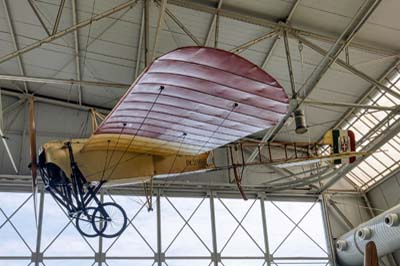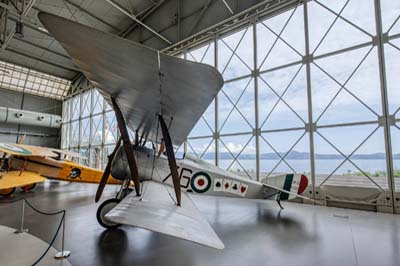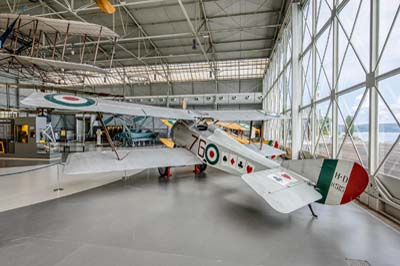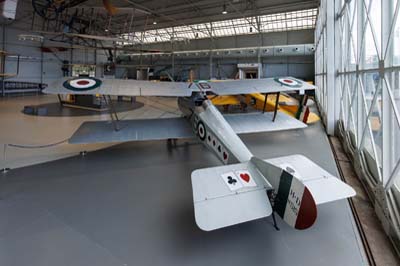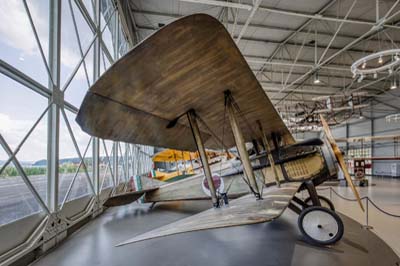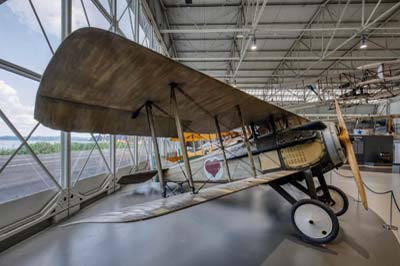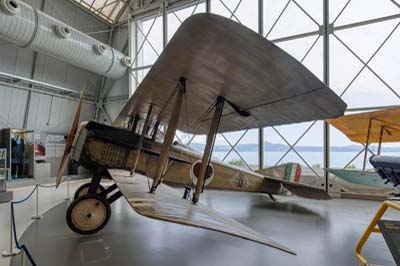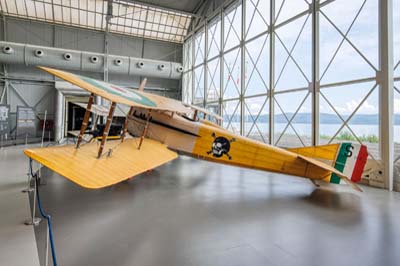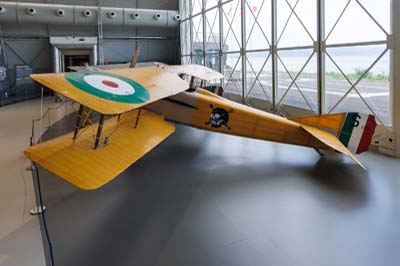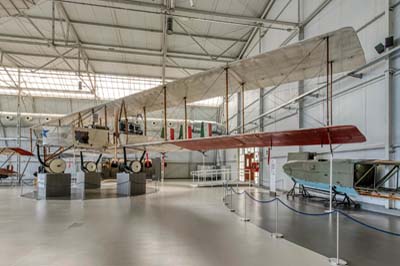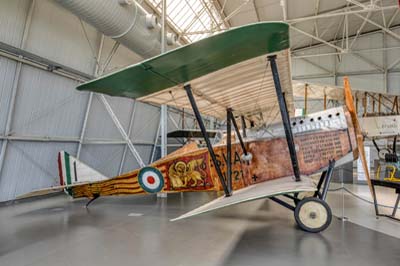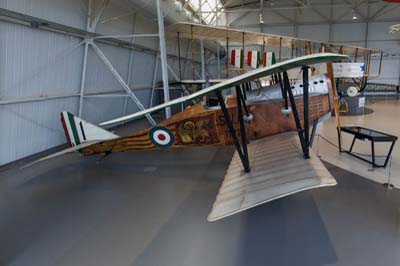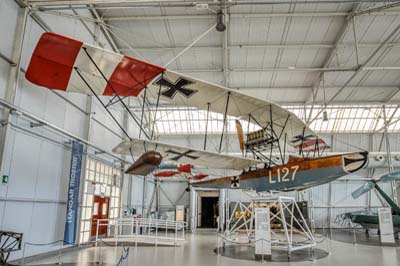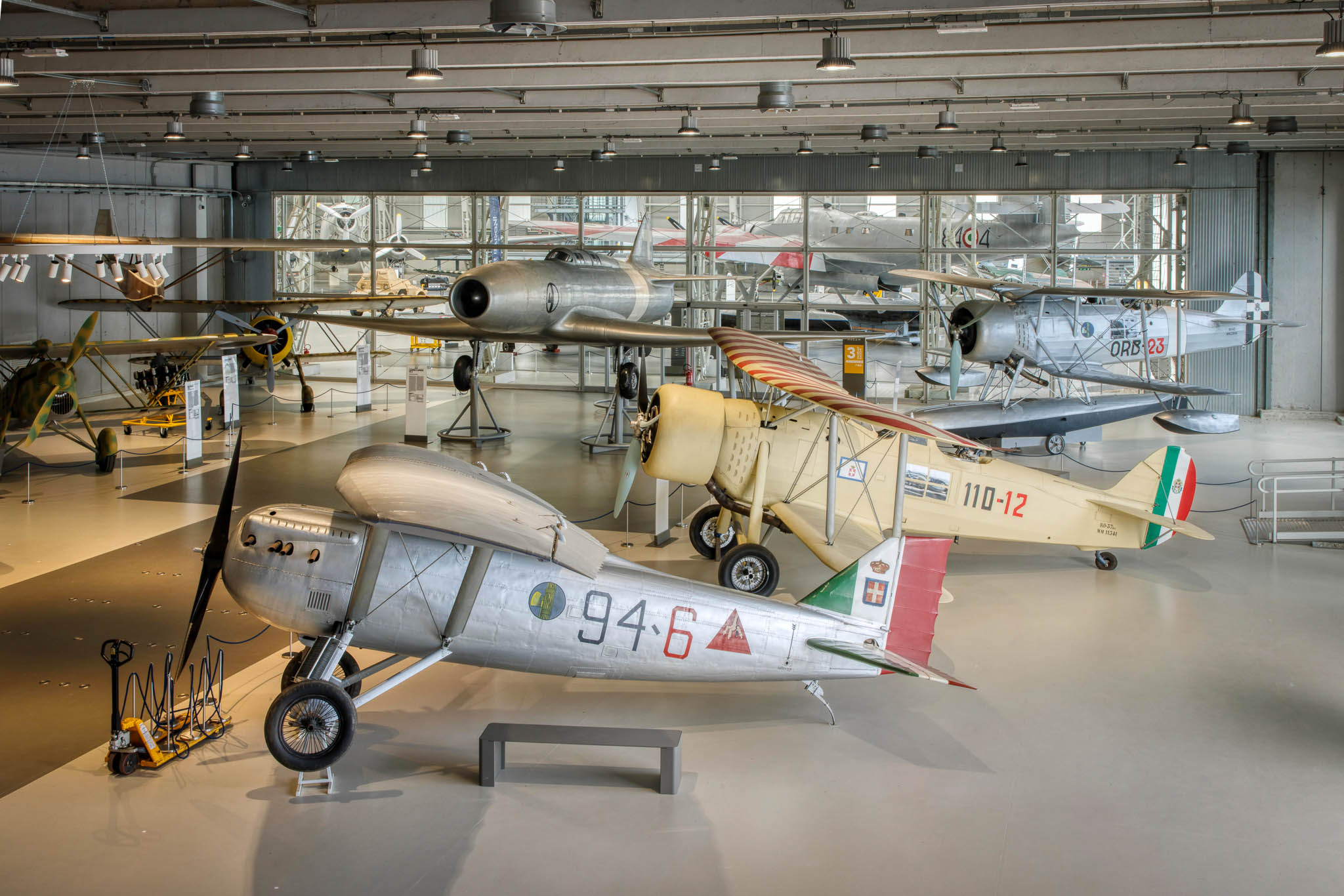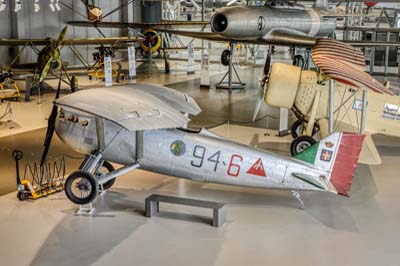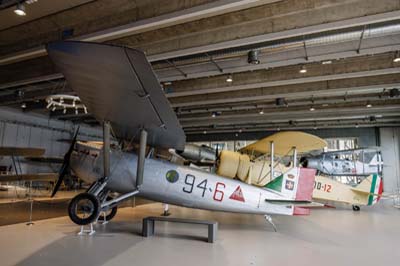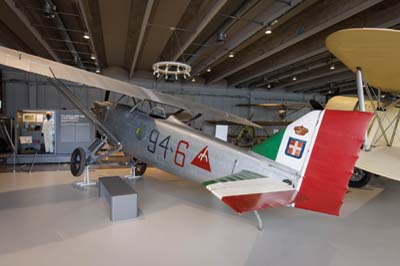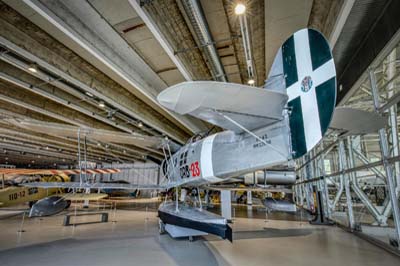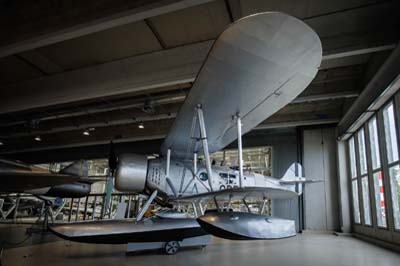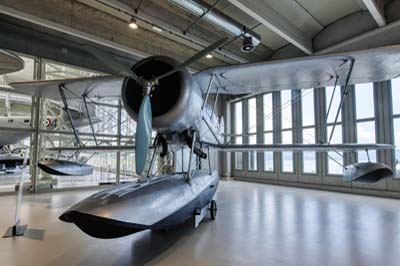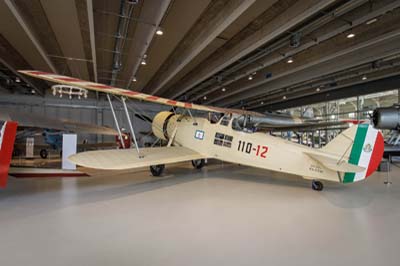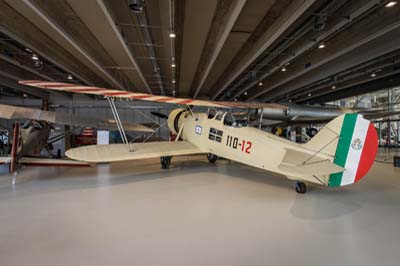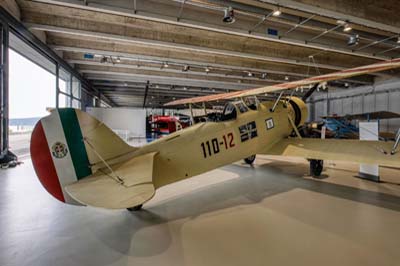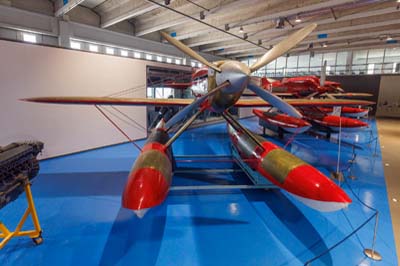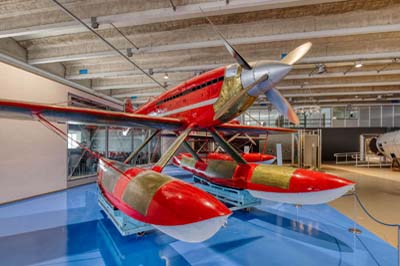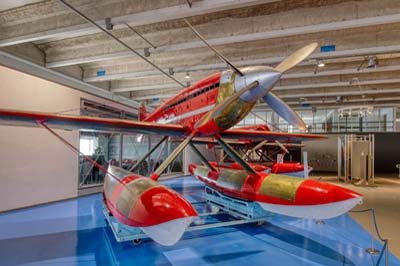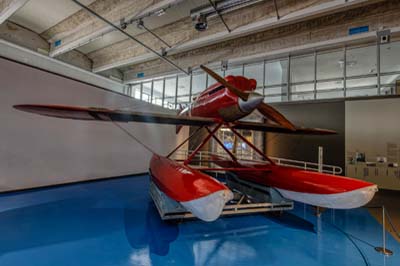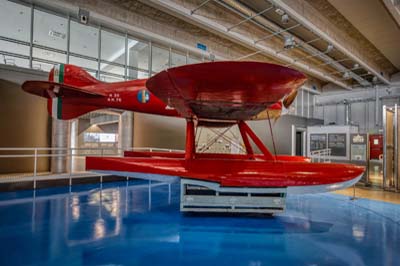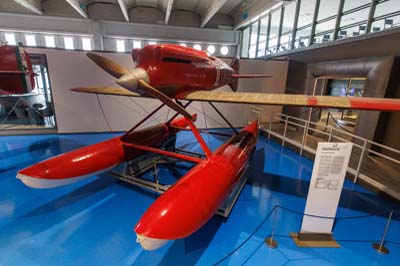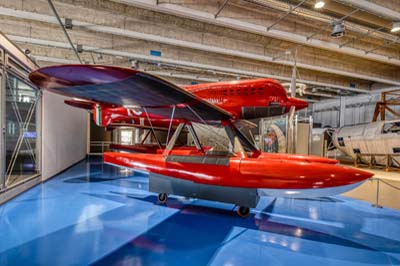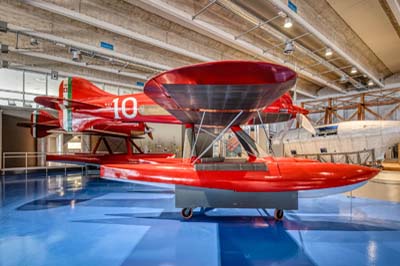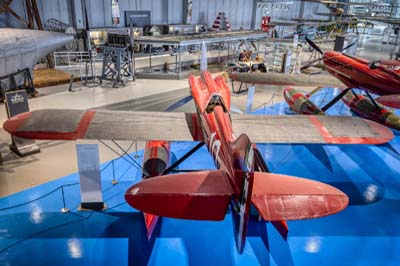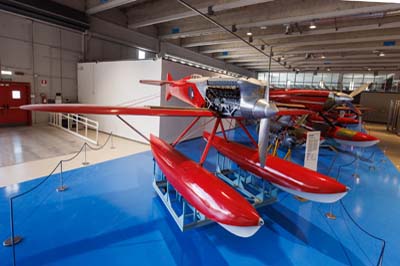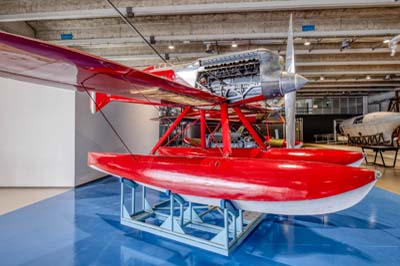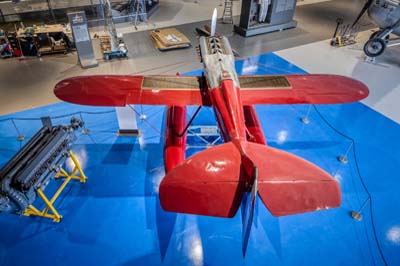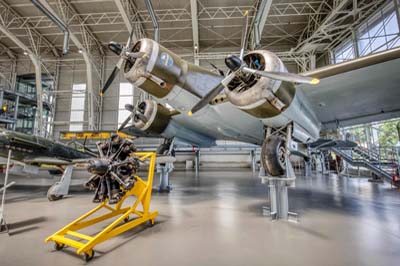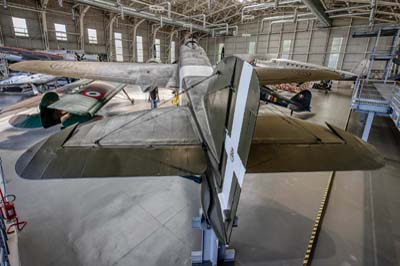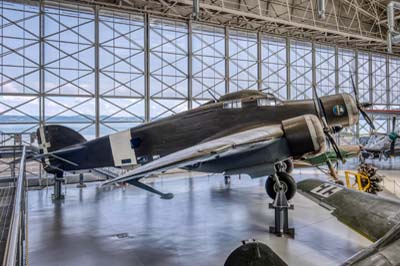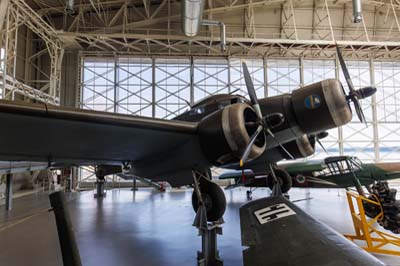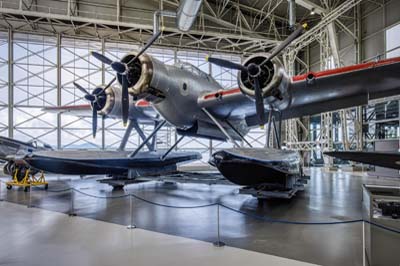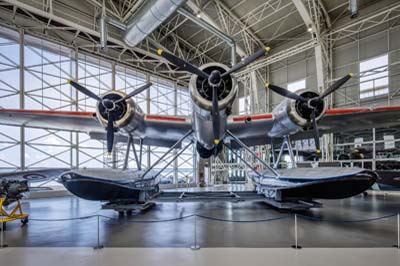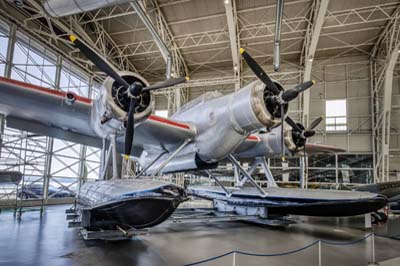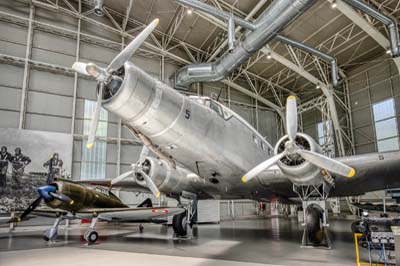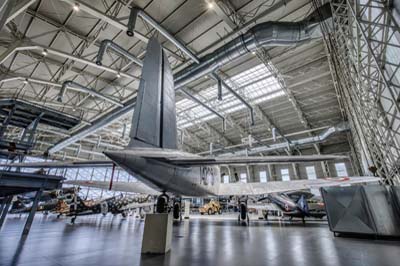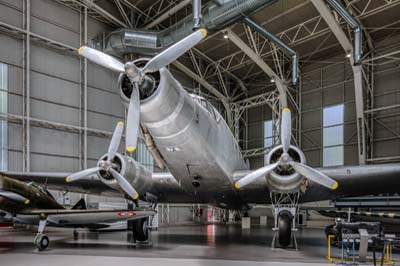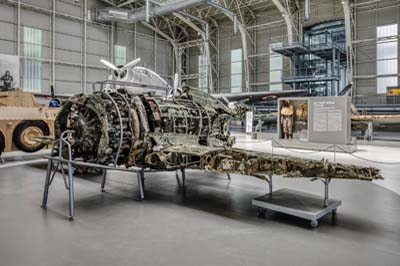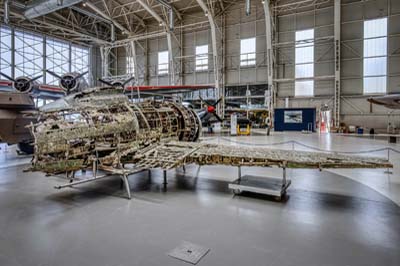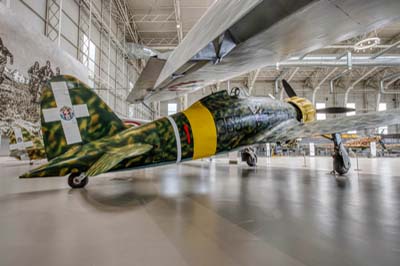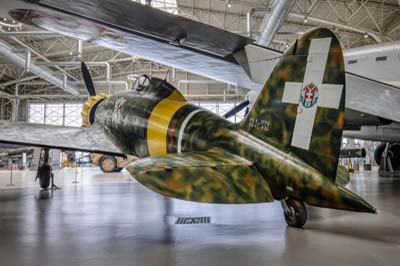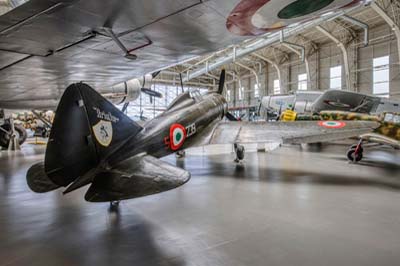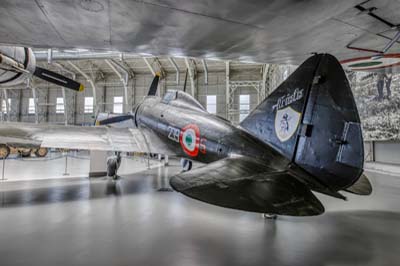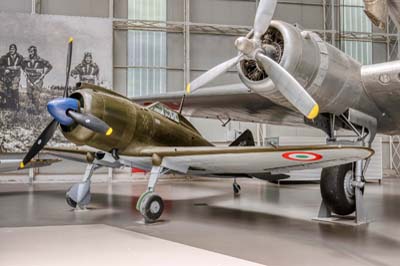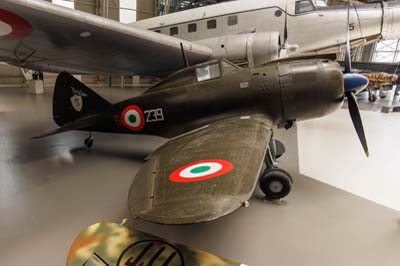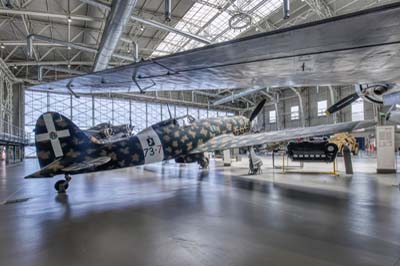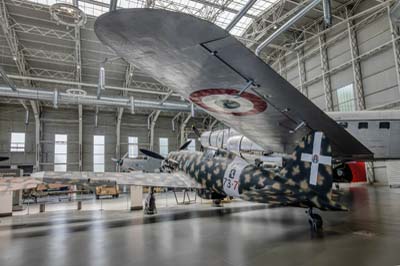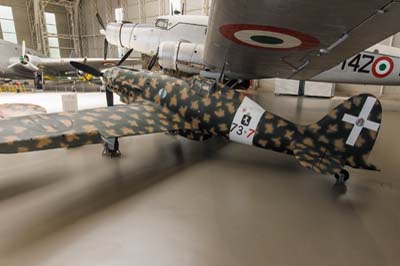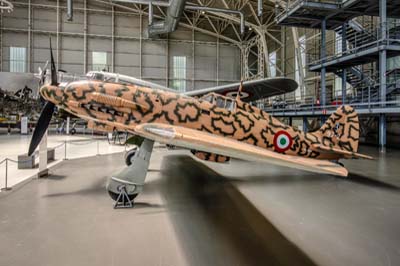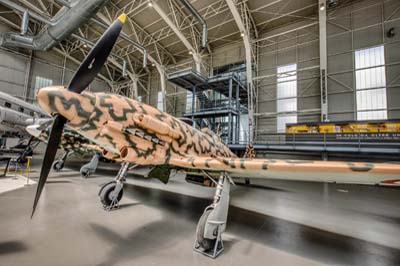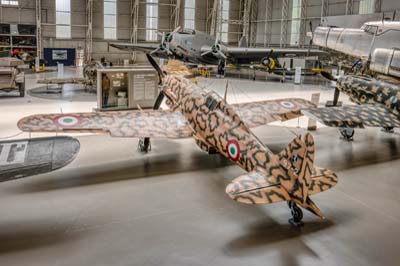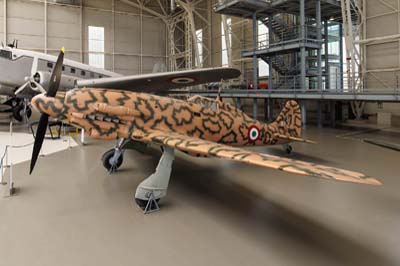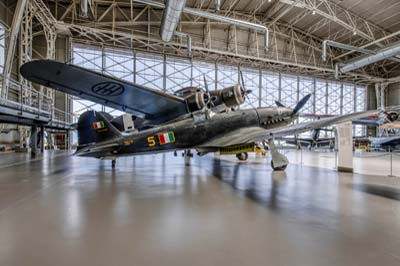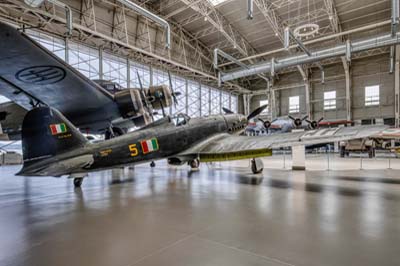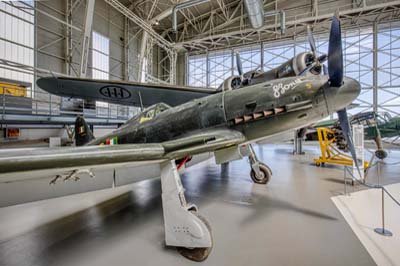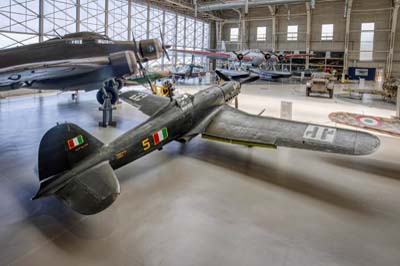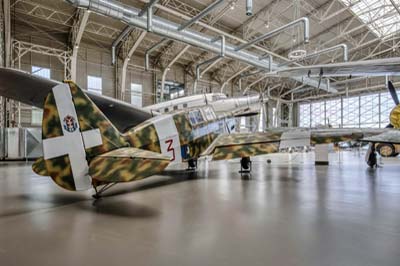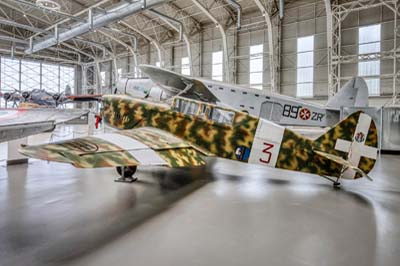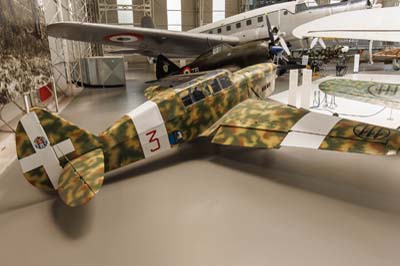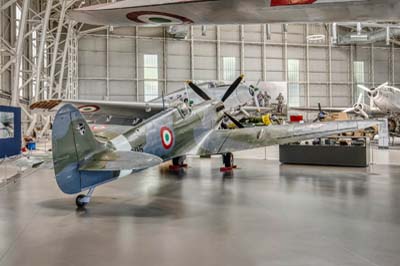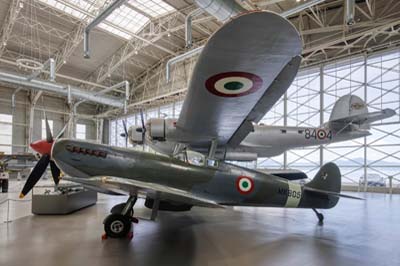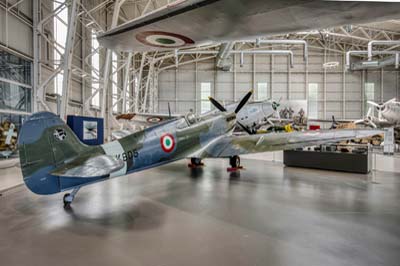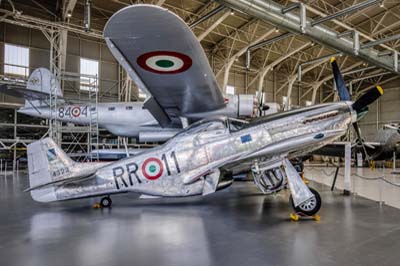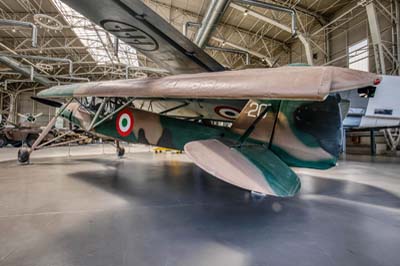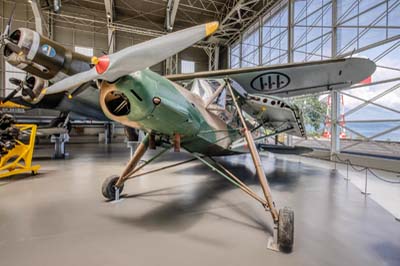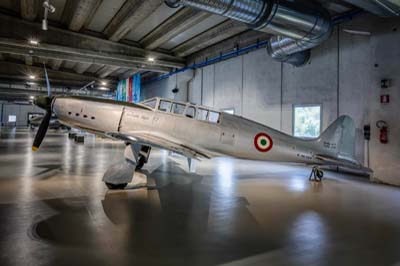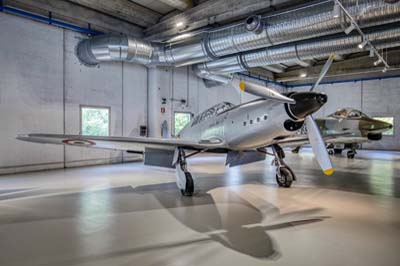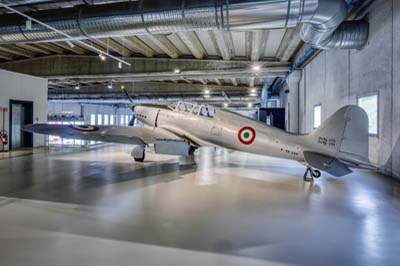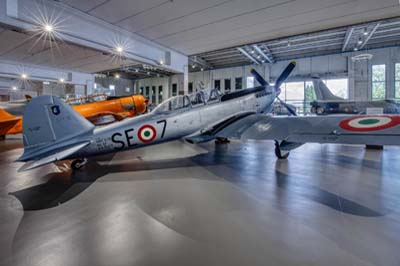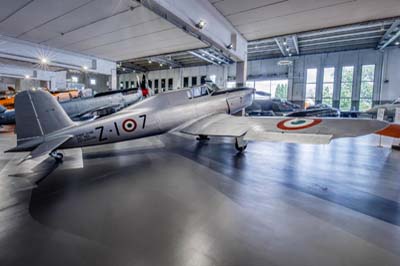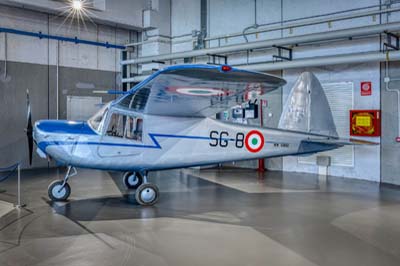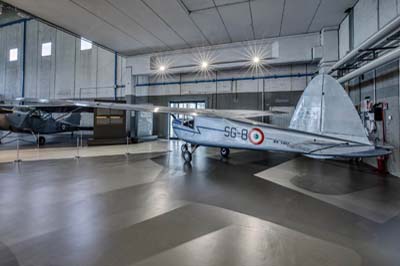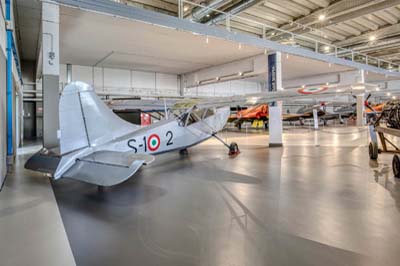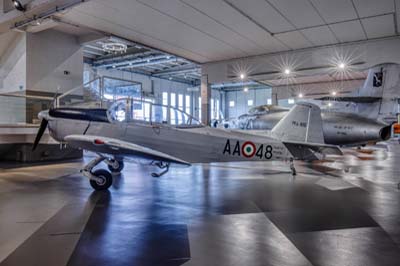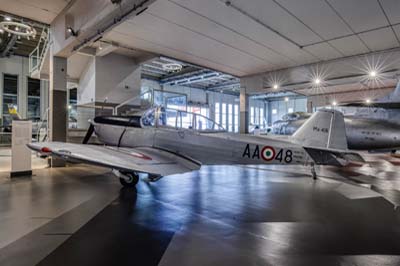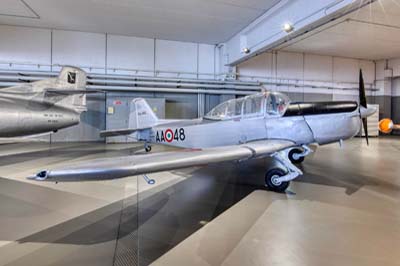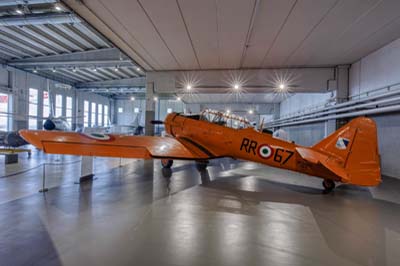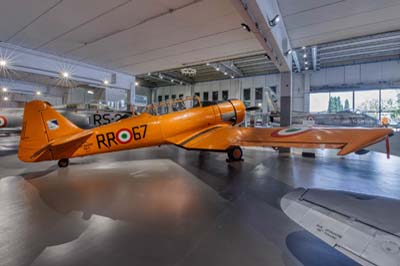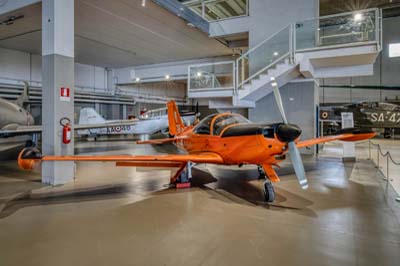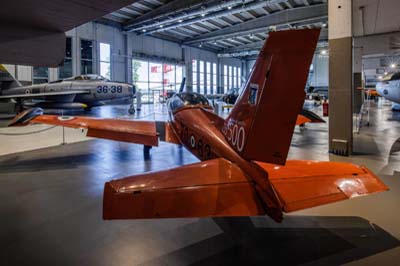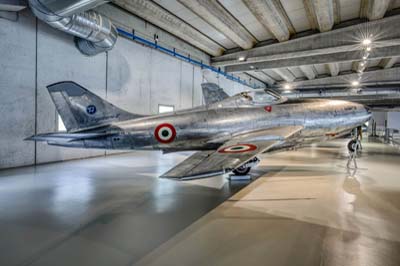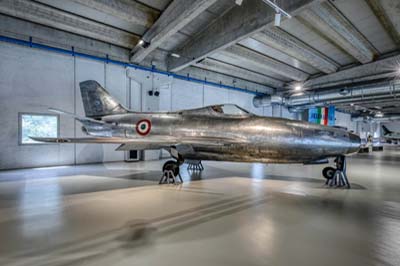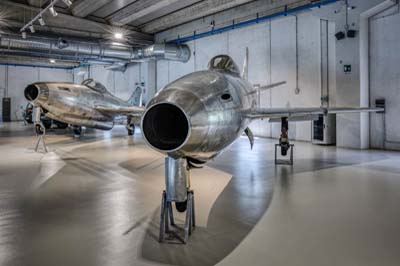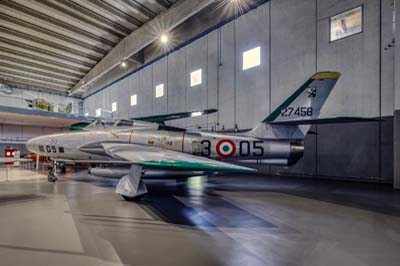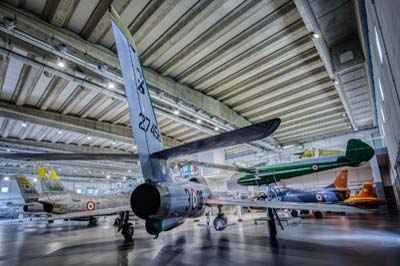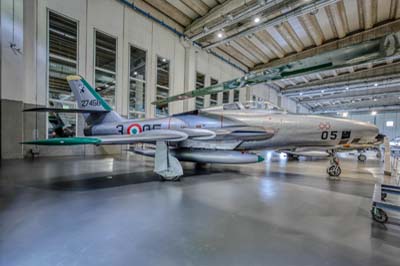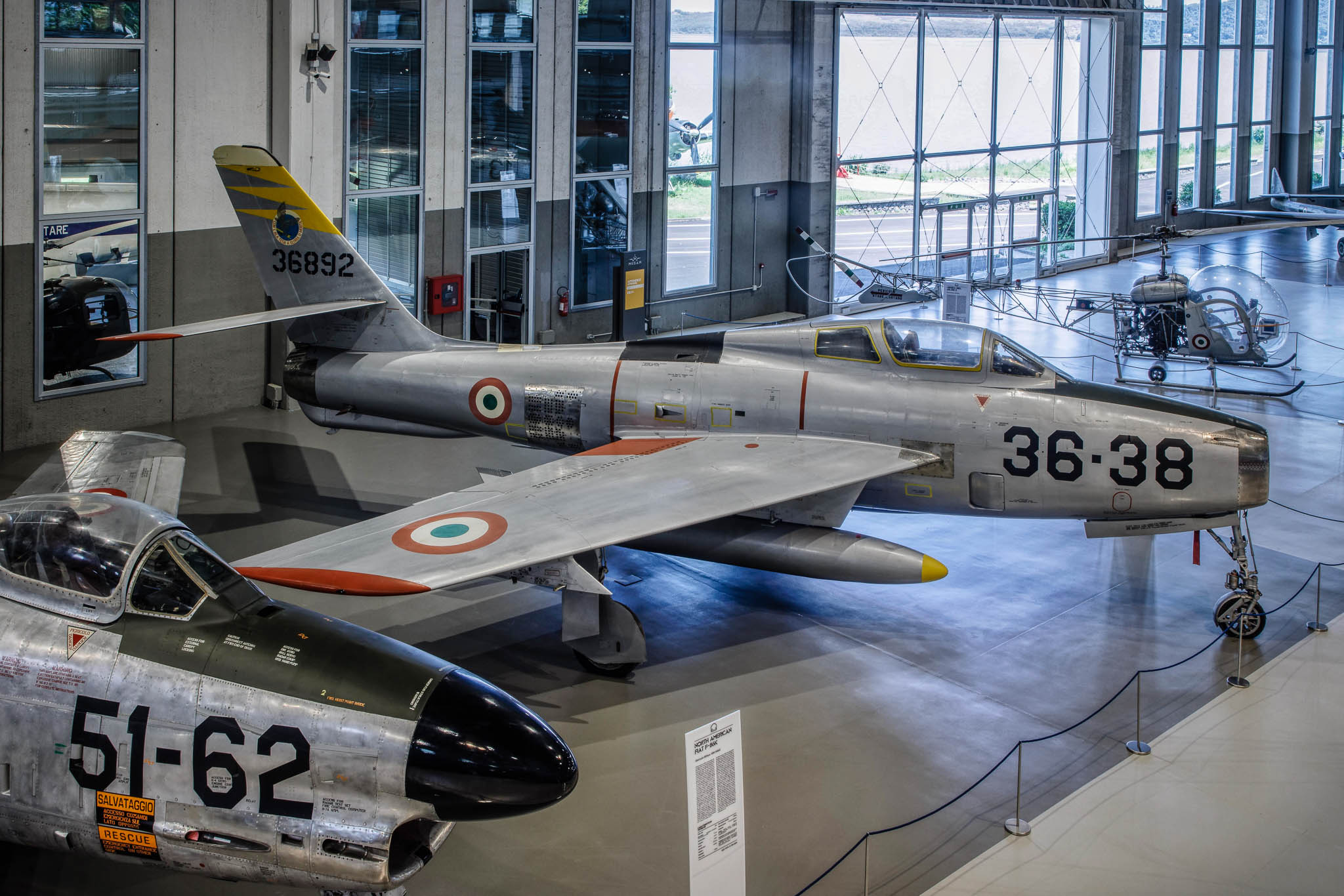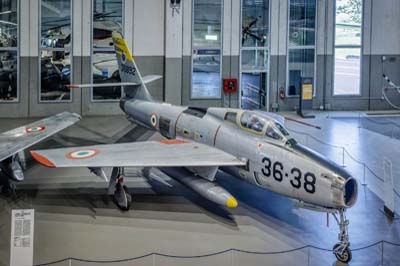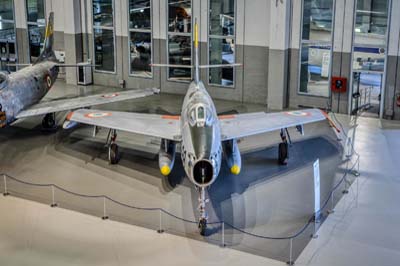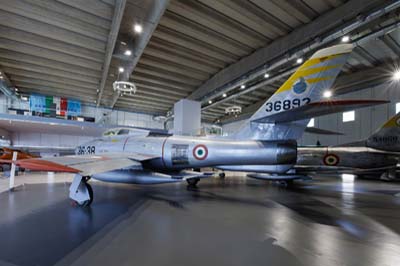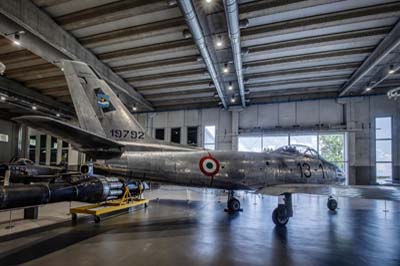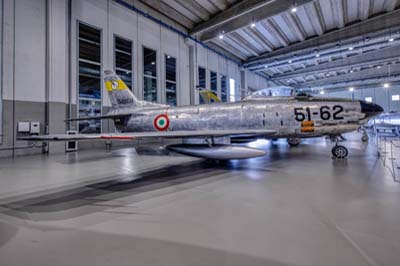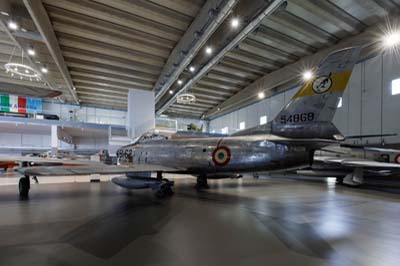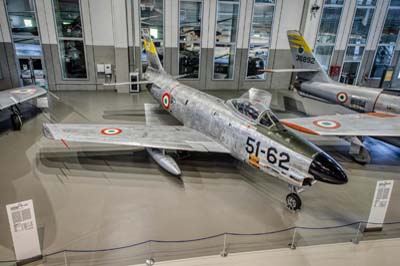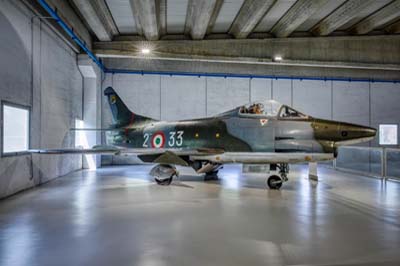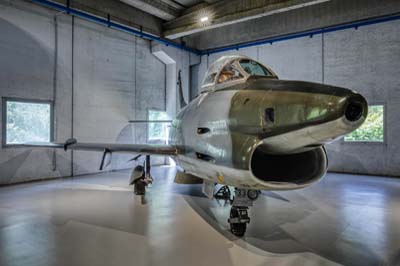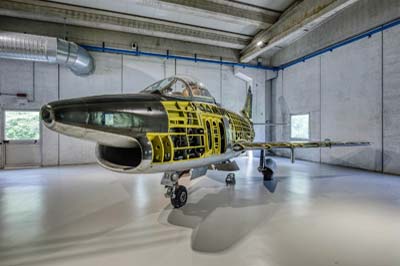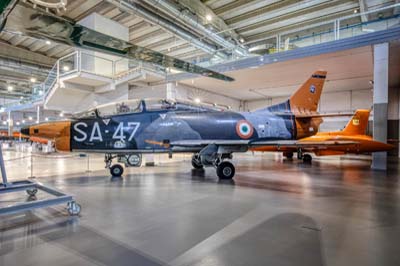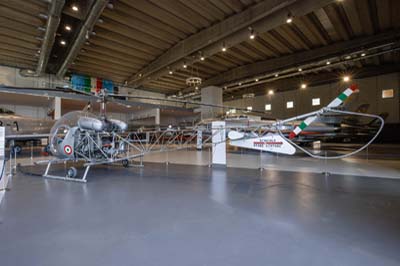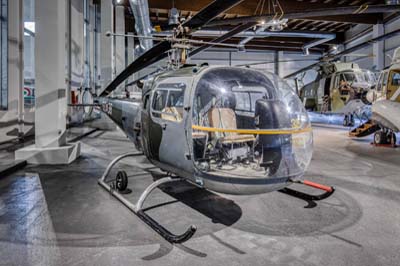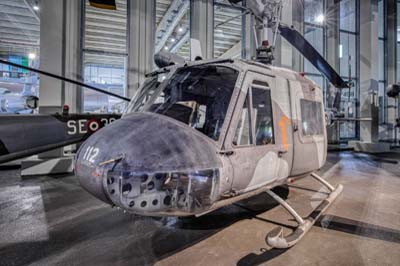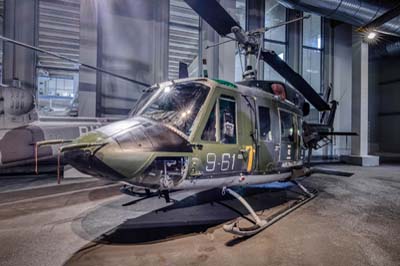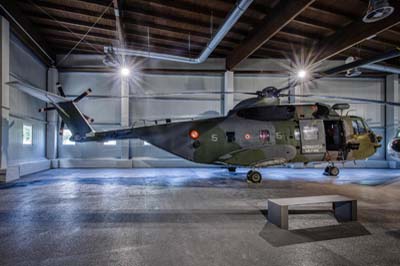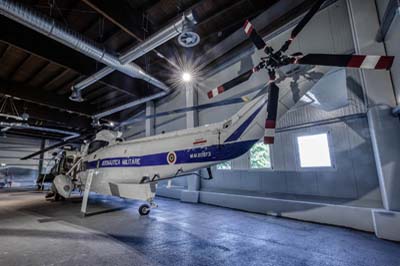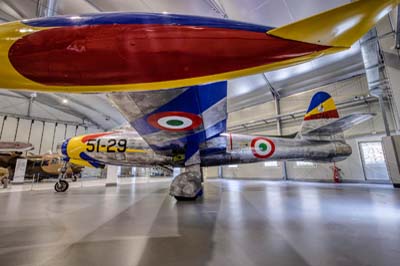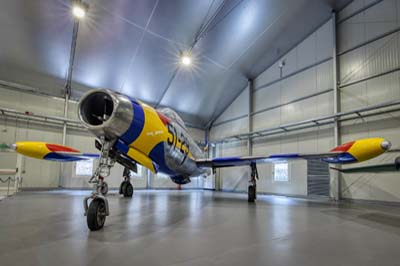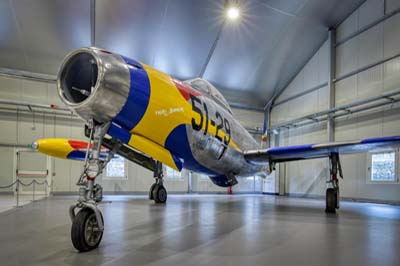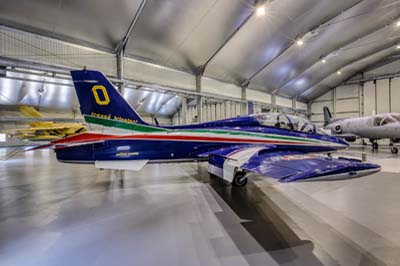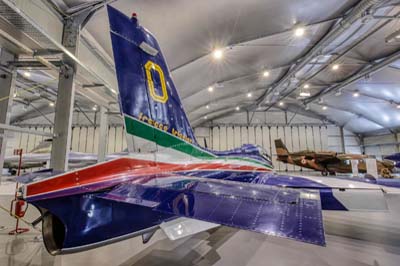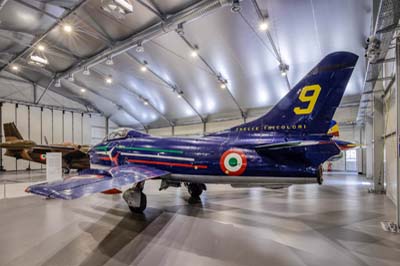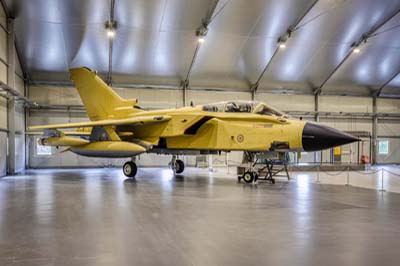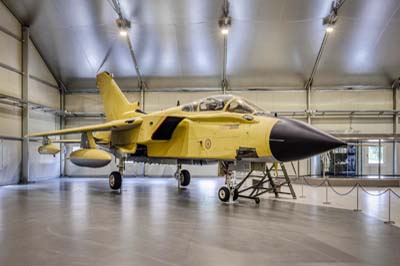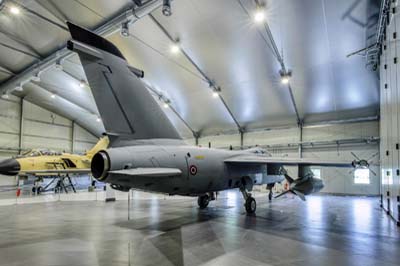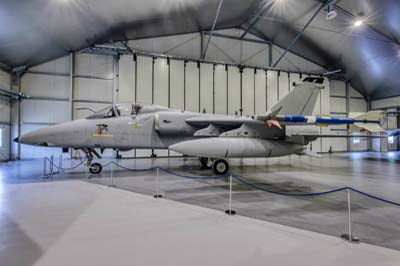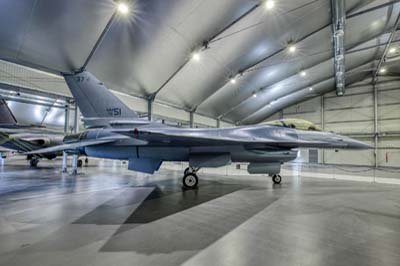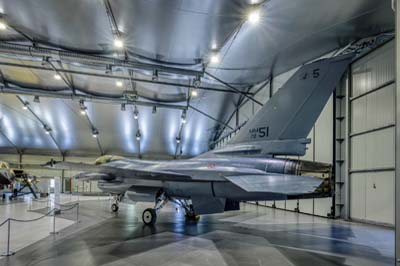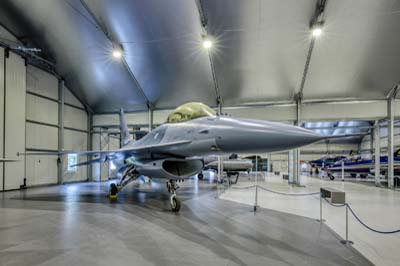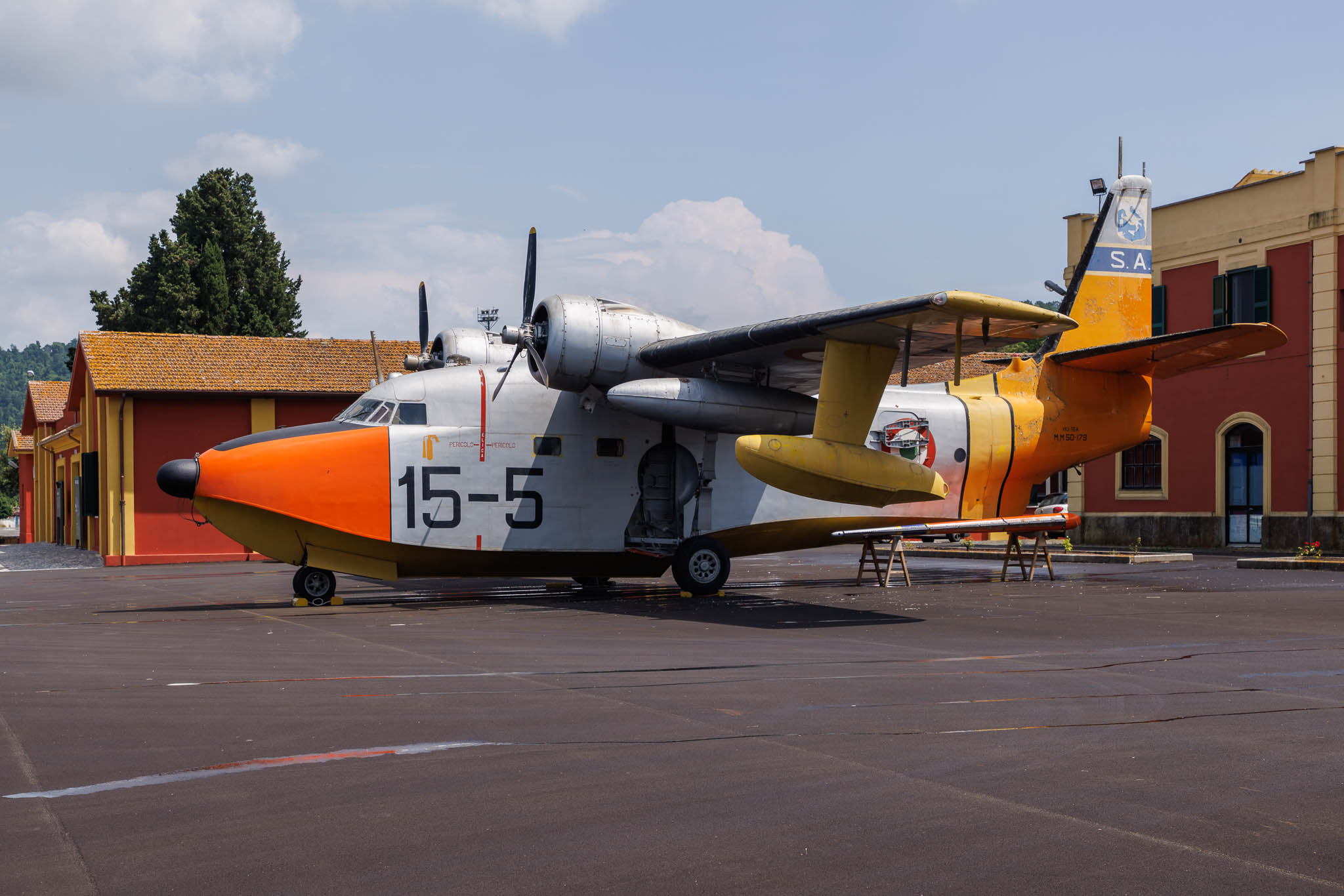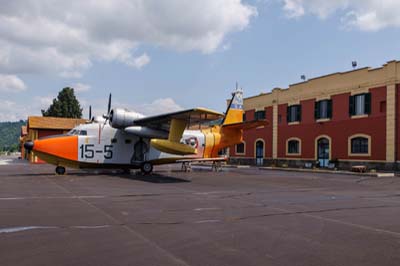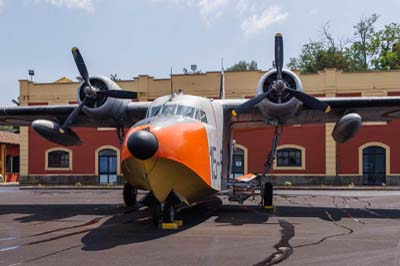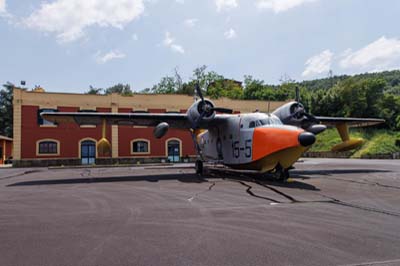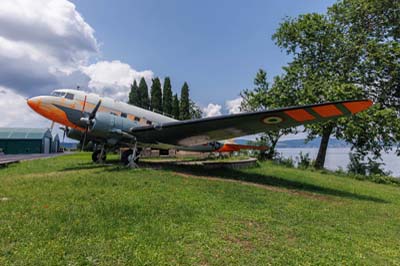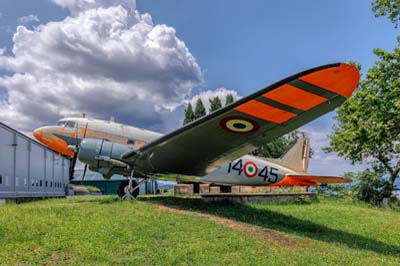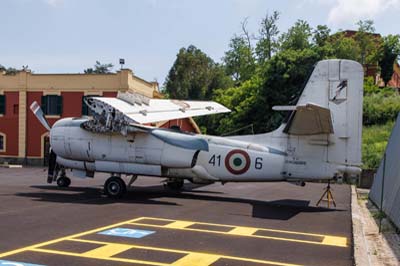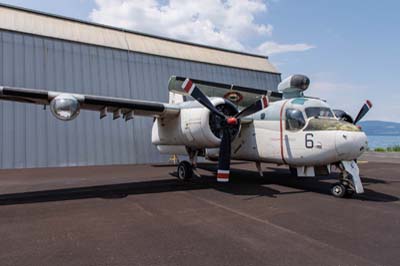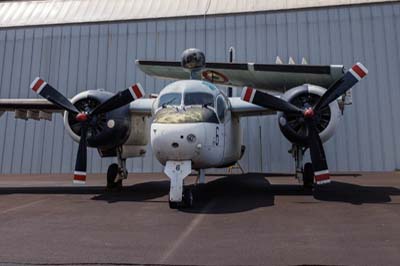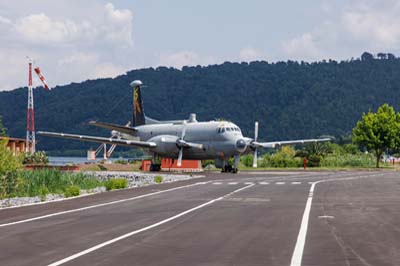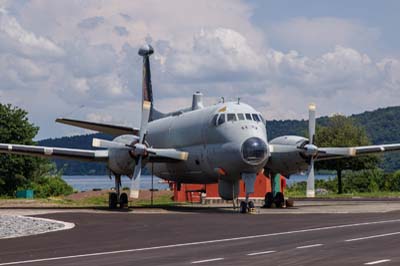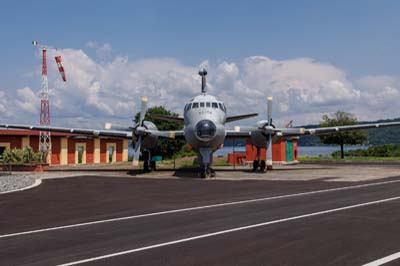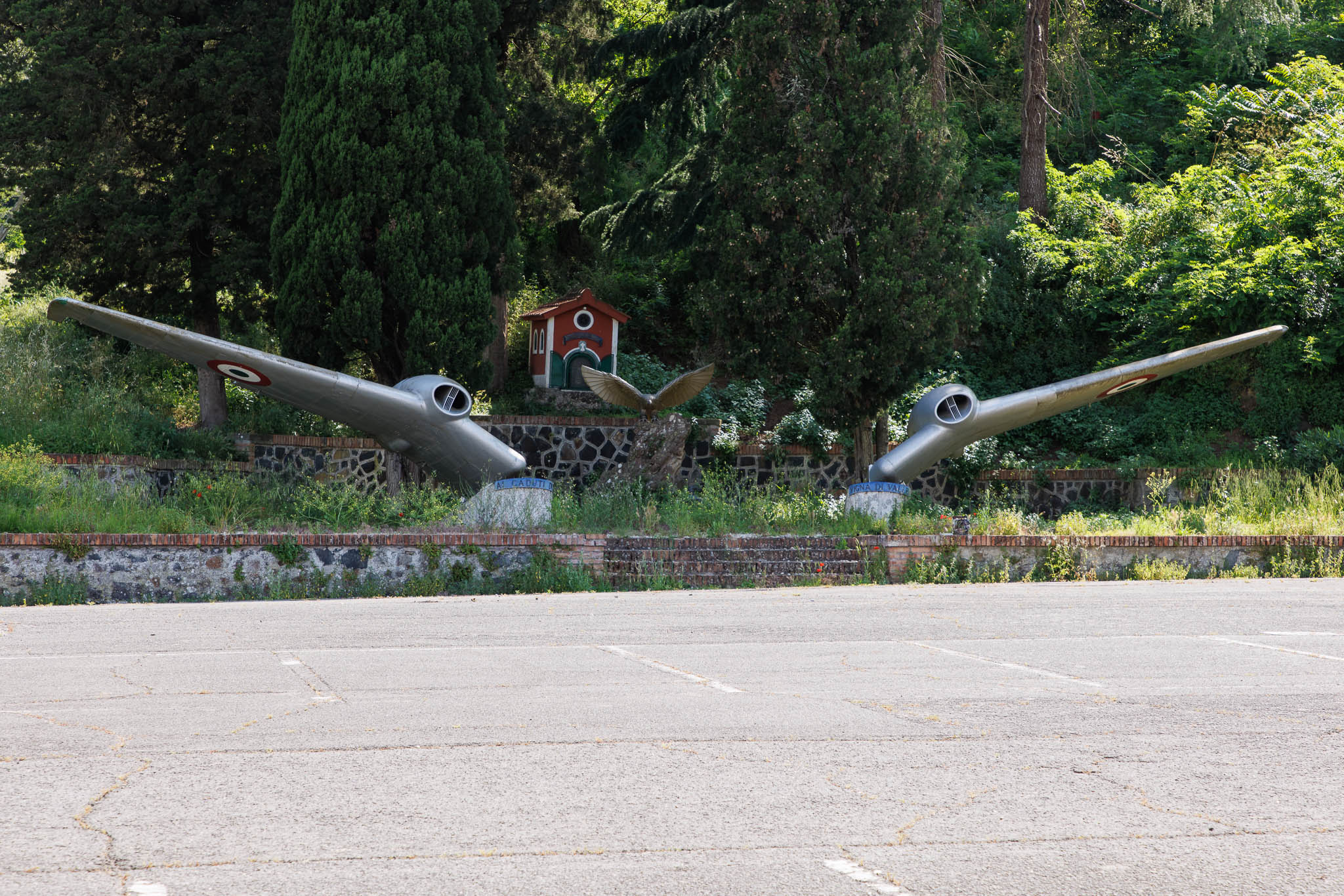The Italian Air Force Museum
(Museo Storico dell' Aeronautica Militare Italiana)
Vigna di Valle, Rome
2023 |
Ready for the 100th Anniversary?
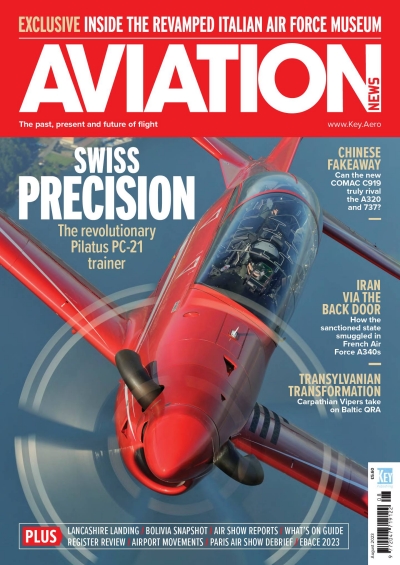
The Italian Air Force Museum (Museo Storico dell’ Aeronautica Militare) at Vigna di Valle has undergone a major overhaul for the air arm’s centenary. Philip Stevens reports for Aviation News he took a sneak peek at the reimagined museum before it reopened.
Deputy Chief of Staff of the Italian Air Force, General Aurelio Colagrande spoke at the official inauguration on May 4: "We are extremely proud of the work accomplished. We feel that aviation enthusiasts will appreciate the improvements and layout of the collection. We still have to apply a few tweaks, but the overall result is already impressive." At this event it was announced that the museum would be opened to the public in two weeks time. It was actually re-opened to the public on June 16, 2023.
|
 |
A panoramic image shot taken from a drone flying over Lake Bracciano. It shows the whole of Vigna di Valle air base and the museum hangars or halls along the shore line in April 2023.
From right to left: Hangar 100, Skema Hall was added in 1993 with an annex added to it in 2009, Badoni Hall (1930) is connected to Troster Hall by Velo Hall, built in 1976 for the opening of the museum.
Photo credit: My friend, Fabrizio Sanetti-Italian Air Force Museum of Vigna di Valle. |
Extensive reconstruction of the whole museum had taken place over the previous 18 months in readiness for the 100th anniversary of the Italian Air Force celebrations. Commanding Officer Colonel Luigi Barbagallo, posted to the Vigna di Valle base is responsible for managing the project known as 'MUSAM 2023'. In an exclusive interview he admitted when he arrived: "I did not have particular interest in historic aircraft but now I do, it’s natural that here you feel involved with the Italian aviation history." Col Barbagallo had worked with the Chief of Staff of the Air Force in Rome as a human resources specialist. This project employed a team of 120 personnel, he said: "Everything has changed in the museum, the infrastructure, the floors, the lighting, graphics, and IT, I had to coordinate all their activities. The biggest challenge was the very short period we had do this work." Despite the museum’s reopening to the public being just days away at the time of my visit, Col Barbagallo conceded: "The work is not finished even though the museum is about to open, we have lots of groups and associations that want to come here. We now must manage how the museum operates, it is a different museum now. This involves the audio guides, the new bookshop and ticket office, re-modelled cafeteria, and conference room. Everything must work well." The museum has been free to enter since it first opened in on May 24, 1977, but Barbagallo said the Air Force Chief of Staff had to consider the best way to fund the operation. So far, the project had been funded by the Ministry of Defence and included money for aircraft renovations. Now, there is an admission fee, but with some exclusions for current and former military and civilian defence personnel.
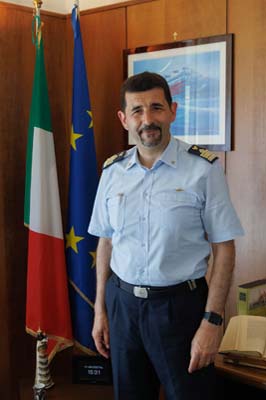 |
Vigna di Valle Commanding Officer Colonel Luigi Barbagallo. |
What’s new?
The exhibition area has expanded by 30%, it now covers 52,500 sq ft (16,000 m2). The new ‘Hangar 100’ has been constructed, painted green it houses the more modern aircraft in the large collection. A space has been left here for a Eurofighter Typhoon which is to arrive after the 100th anniversary air show at Pratica di Mare where it was on display. Inside the double-span hangar was new arrival, a Tornado IDS resplendent in a stunning 1991 Gulf War desert yellow ‘Canarino’ scheme, as applied for Operazione Locusta when part of Operation Desert Storm. During Operation Locusta, the Italian Air Force Tornados flew 1,108 missions dropping 565 bombs between October 1990 and March 1991, they operated from Al Dhafra Air Base, near Abu Dhabi, United Arab Emirates.
An historic building at the opposite end of the Lake Bracciano shoreline has been made available to house a large aero-engine collection which includes a Bariquand & Marre Wright Vertical 4, designed by Orville Wright and built in Paris under license till 1910. It is the oldest aero engine still working in Europe. Here also, is a multimedia area with flight simulators and virtual reality.
The existing hangars or halls now have two tone grey painted floors. Air conditioning has been installed which will protect the priceless exhibits and new LED lighting fitted to provide an attractive bright appearance to each building. The obtrusive amateur paintings and other ‘clutter’ which in my opinion detracted from the collection has all been removed to my delight. The existing aircraft which totals around 80 have nearly all moved to new locations in each hall and are now more evenly spaced, I am sure will be appreciated by all photographers. Re-designed information boards have been designed and new rope barriers are placed around the exhibits.
The collection now includes the oldest aeronautical relic in the world, a recently restored balloon constructed by French balloonist André-Jacques Garnerin who died in 1823. Two other recent arrivals are an Agusta-Bell HH-212 and a Sikorsky HH-3F Pelican.
Some of the inmates have been renovated, notably the Savoia-Marchetti SM.79 Sparviero which was restored onsite, or should I say, "patched up", in the Badoni Hall over a three month period by two restorers under the Superintendent of Cultural Heritage. New fabric was placed over the original fabric which had cracked over many years on display in a hangar subject to vast daily temperature changes. The original fabric can still be seen from the inside of the aircraft. Replacing the distinctive green/sand camouflage, the all over olive green paint scheme now applied is authentic from the time the aircraft was delivered to the Aeronautica Militare in 1936. The aircraft is now devoid of its serial and squadron code as is a Piaggio P.166ML1 which has also been repainted.
The beautiful and only surviving Reggiane Re.2002 Ariete has returned. On completing its restoration in 2017 and unveiling for the 40th anniversary of the museum, it had been removed from display not long after.
Some aircraft have left the site, the Savoia-Marchetti S.56, Partenavia P.53 Aeroscooter and Aermacchi MB.323, which I believe is now residing in a new museum storage facility at the Piacenza air base.
Historic Vigna di Valle
For those unfamiliar with this wonderful museum, it is situated on a beautiful location beside Lake Bracciano, the historic site dates back to 1904. In 1908 the first Italian military airship flew from here and in 1922 the 2nd Experimental Seaplane Squadron was formed. From 1930 the 88º Gruppo ‘Caccia Marittima’ (Maritime Hunter) was established, initially equipped with Macchi M.41bis and Fiat CR.20 Idro seaplanes. They were replaced by the Cantieri Aeronautici e Navali Triestini (CANT) 10 and CANT 25 and subsequently by IMAM Ro.43 and Ro.44 until their withdrawal in 1945. The only existing Ro.43 reconnaissance single float seaplane is still on display here. In 1948 Vigna di Valle became the headquarters of the Air Rescue Command with 84° Gruppo, operating the CANT Z.506 Airone, a three engine twin-float seaplane, until 1961 when the unit re-located to Rome-Ciampino. The only surviving CANT Z.506 is also in Badoni Hall.
Troster Hall is the oldest aeronautical building in Italy, it was obtained as war reparation from Austria at the end of World War One. It houses the oldest aircraft ranging a Blèriot XI to aircraft from the World War One, including a Ansaldo SVA-5 which took part in the Italian raid on Vienna in 1918.
Unfinished business
Col Barbagallo admitted his work is far from finished, marketing plans need to be drawn up and visitor numbers are expected to rise. Before the museum closure visitor figures were 50,000 per year. An enthusiastic Col Barbagallo spoke: "My first objective is to increase the number of visitors because of the importance of the museum to the Air Force, I would like to increase the visitor numbers by ten times." He added: "The museum has to be known across the region and across the country. Many of our visitors are school children, we want the visitors to fall in love with our Air Force because they are our future." In conclusion he said: "I very much like working with all the people involved in this project it’s clear to me that managing the museum is not just a job, it is a passion for me and my staff.
|
The Aircraft Collection
On June 16, 2023 the museum was re-opened after 18 months of extensive renovation as part of the Italian Air Force 100th Anniversary commemoration. This followed a period of closures of hangar 3 and 4 which required some structural work of some sort. |
| Hall 1 'Troster' The beginning of flight |
Left to right: Blériot-SIT XI-2 (BL246). Designed by the French aviator Louis Blériot in 1909. The French, British and Italian air forces took delivery of 132 Blériot XI's from 1910. The Blériot was the first aircraft to be used during war when it was flown by the Italian Air Force in 1911 during the Italy-Turkey war of 1911 and later in the Libyan war of 1912. The aircraft on display is inscribed 'XIII Squadriglia BL 246'.
Macchi Hanriot HD.1 (unknown serial, coded '76'). This is a French designed World War One single seat fighter which was supplied to the Belgian and Italian air forces, the French chose the Spad S.7 instead. Around 1,200 were delivered of which 831 were built in Italy by Nieuport-Macchi of Varese under license between 1917 and 1919. By November 1918 16 of the 18 Italian fighter squadrons were equipped with the aircraft. After the war a number of these aircraft were passed to the Swiss Air Force.
The example on display was flown fighter ace Lieutenant Flavio Torello Baracchini who was credited with 21 confirmed and nine unconfirmed aerial victories, ranking fourth of all World War One Italian aces. |
Spad S.VII which was was piloted by 'ace' Ernesto Caburna it still shows where numerous bullet holes were stitched up after encounters with the enemy.
Many Spad S.VIIs were built during World War One for the Italian, British, French, Belgian, Russian and US air forces. |
| Spad S.VII (S.153) was presented to 'ace' Fulco Ruffo di Calabria after he had scored 20 victories in 1919. Ruffo later presented the aircraft to the Air Force Academy in the 1930s. Ruffo succeeded Francesco Baracca as Commander of the 91st Squadron. During restoration in 2001 by GAVS in Rome it was discovered that this aircraft was built in September 1916, making it the oldest in existence. It has Ruffo's 'skull and cross bones' insignia on the side. A replica Spad S.VIII ('S.1420') was on display here from 1980 till 2004. |
Left to right: Caproni Ca.3 (23174) is a three-engine bomber, unusually having two engines pulling and one pushing. The Ca.3 was derived from the Ca.1 which first flew in 1914 and had three Fiat A10, 100 hp engines. In 1917, 270 Ca.3s were built and delivered with more powerful 150 hp engines. Many bombing raids were carried out by these aircraft during World War One, notably at Assling, Chapavano and at the naval base at Cattaro. Interestingly the example on display was flown in World War One by Lt. Casimiro Buttini, when he got the Gold Medal of Valor. After the War he bought his aircraft for 30,000 lire and stored it in a barn in the Piedmont mountains. It was kept safe till 1959, when it was bought back by the Italian Air Force for the museum. By March 2008 the example on display had received some additional paint work.
Ansaldo SVA-5 (11721) was designed by Savoia and Verduzio and built by Ansaldo (SVA), with over 2,000 being delivered from 1917. It was Italy's first all Italian aircraft and the fastest of World War One. Used mostly for reconnaissance, its most memorable sortie was made by aircraft from 87th Squadron over Vienna on August 9, 1918, when they dropped leaflets inviting Austria to surrender. It is one of these actual aircraft (11721) which is on display in Hall 1. After the War two SVAs flew an amazing 11,250 miles (18,000 km) to Tokyo. Another SVA flown by Antonio Locatelli, who was awarded the Gold Medal, was the first to fly solo over the Andes.
Lohner L-1 (L-127). It was designed by Jacob Lohner & Co of Vienna. By 1917, 93 had been built and put into service for reconnaissance and bombing. The example on display was actually one of 24 built under license by Ungarische Flugzeugwerke A.G of Budapest. It was delivered to the Imperial Royal Navy in June 1916 and took part in bombing raids against Italian positions. On June 3, 1918, while based at Lussino and used for reconnaissance over the Dalmatian coastline, it was taken by two defecting naval pilots of Italian decent, who flew it across the Adriatic to Fano, where it was captured. After extensive restoration it was transferred to the museum in 1988. |
The Ansaldo AC.2 (MM1208 coded '94-6') first flew in 1924 and went into service as a fighter in the following year. It was license-built Dewoitine D.1 which first flew in 1922. A total of 112 were built in Italy. An Ansaldo AC.3, which is a license-built Dewoitine D.9 of which 150 were built, was flown by test pilot Donati to set the world altitude record of 38,914 feet (11,861m) in 1926.
As photographed in; 1986 and 2002.
|
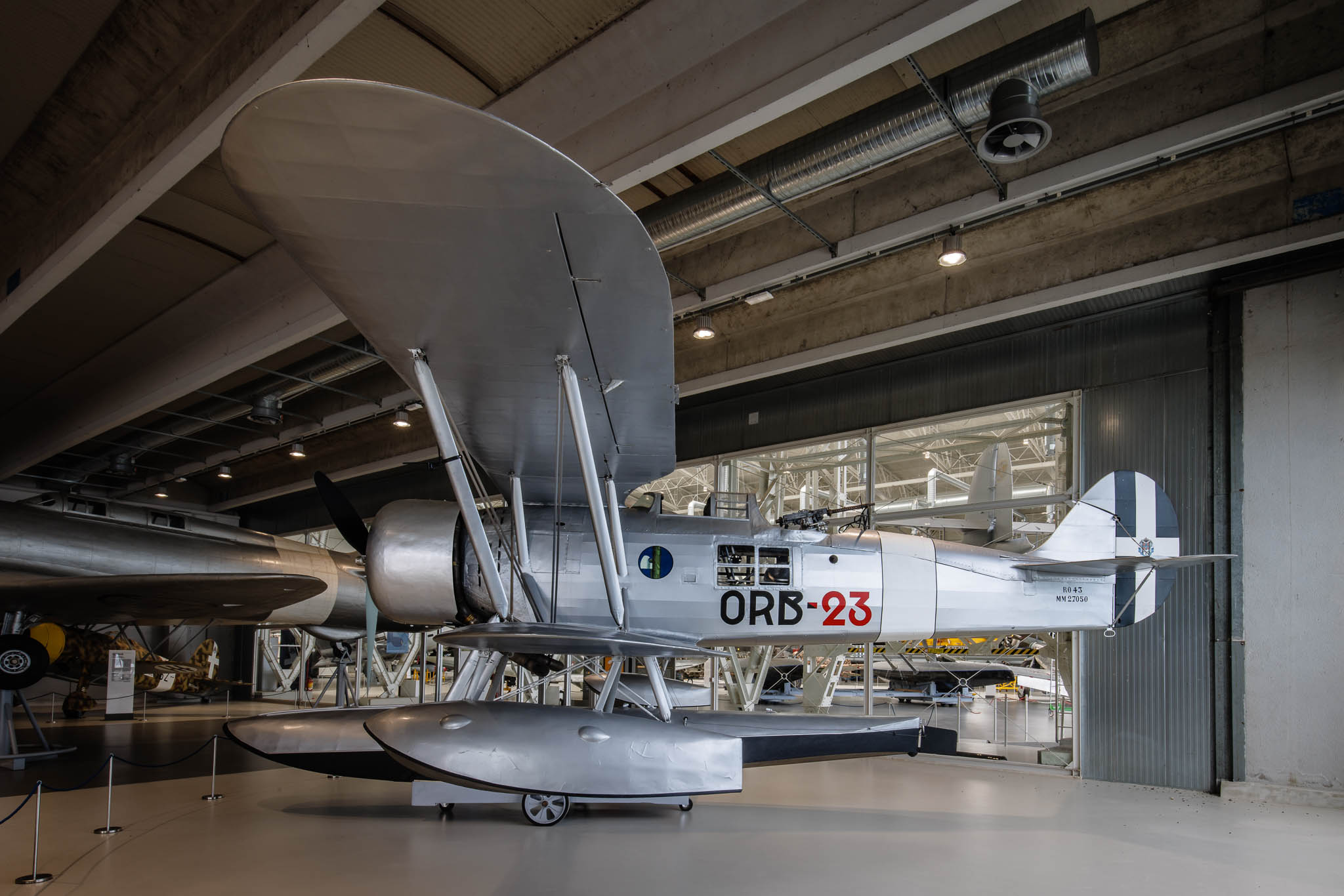 |
IMAM Ro.43 Maggiolino 'Cricket' (MM27050 'ORB-23'). It was built from 1934 to 1941 for the Regia Marina (Italian Navy) as a spotter plane and launched by catapult from their battleships. Although between 200 and 240 were built at the start of World War Two only 105 were in service and by 1943 only 48 were still flying. The design was not very successful it has poor sea handling characteristics and its lightweight construction meant that it was difficult to recover at sea.
The aircraft on display was built in 1937 and is the world's only survivor. It ended its military operations with the Observatory School at Orbetello (ORB). In 1972 it was found at Centocelle, Rome and was refurbished for the Museum where it remained till at least 2000 when it was removed for a further two years of restoration which commenced in 2009 before returning in November 2011.
As photographed in; 1983 and 1990. |
IMAM Ro.37bis (MM11341 '110-12'). Production of the Ro.37 two-seat biplane for the fighter/reconnaissance role began in 1934. Eventually 160 Ro.37 and 475 Ro.37bis were built a number of which were exported. AMI Ro.37s were all retired from service by the time of the armistice in August 1943.
The Afghan Air Force took delivery of 18 examples in 1938 and amazingly the Italian Army as part of 'ItalFor-12' and part of the ISAF security force in 2006, discovered six Ro.37bis fuselages in a scrap yard on the outskirts of Kabul. It was believed at the time that there no surviving examples of the Ro.37 anywhere in the world. With all the aircraft recovered to Italy it was hoped that two aircraft could be rebuilt and restored to their former glory. The aircraft on display is now fully restored having returned to the museum from a short display in Milan. |
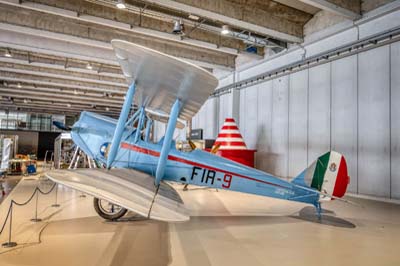 |
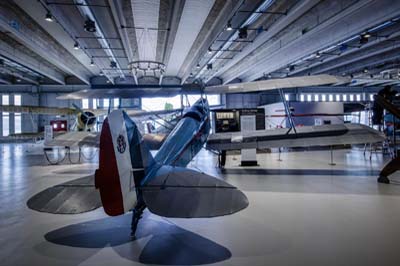 |
| Caproni Ca.100 Caproncino (I-GTAB 'FIR-9') registered in 1951 it had been operated by Aero Club Torino. The Ca.100 was based on the DH.60 Moth and over 700 were built between 1928 and 1937 they were used extensively by flying schools basic pilot training. The aircraft on display returned to the museum on May 24, 2007 and is painted in markings representing a Ca.100 with the Florence basic flying school of the 1930s. It had previously been at the museum for a short period around May 1991. |
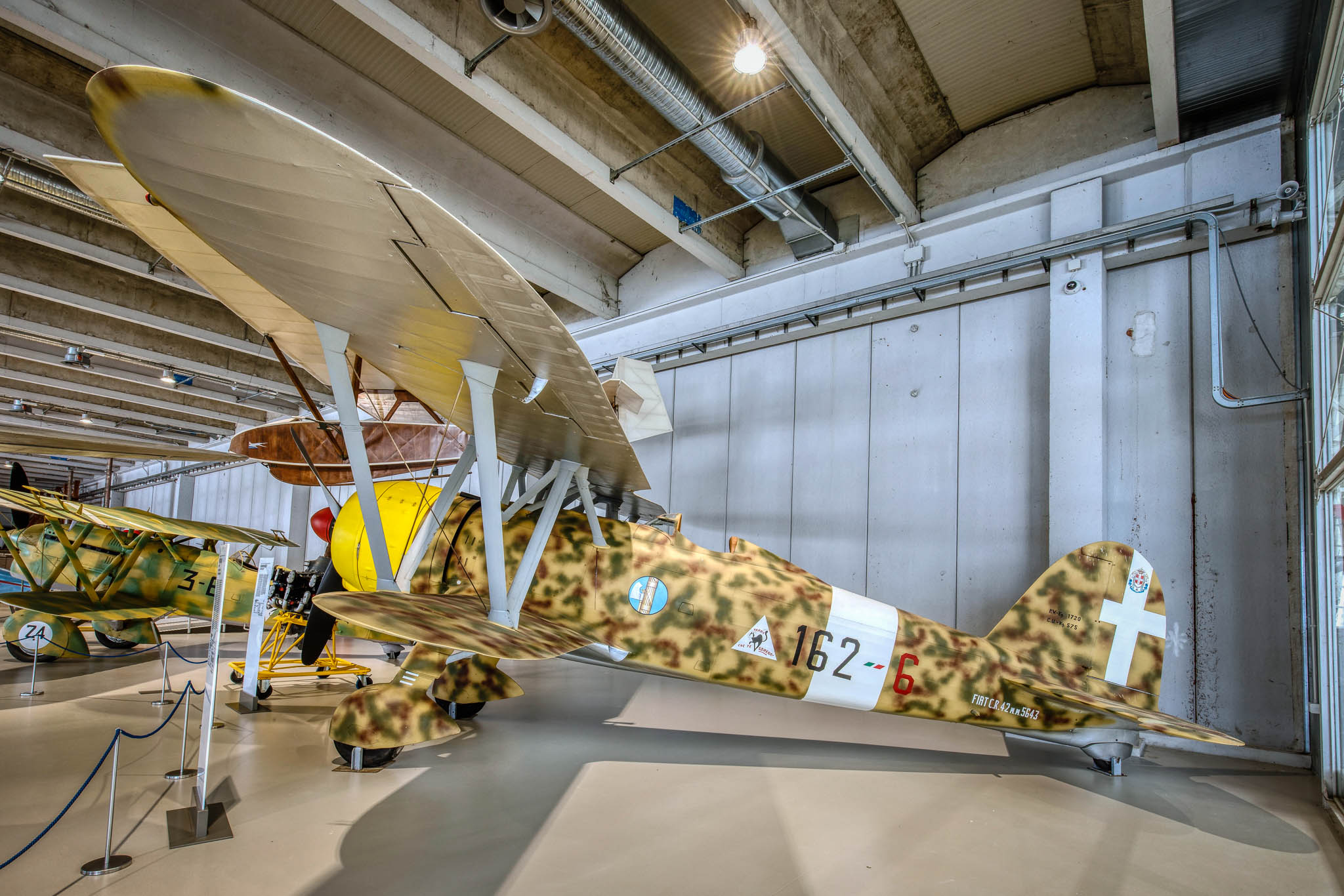 |
The Fiat CR.42 Falco (Swedish Air Force Fv 2539 registered SE-AOP painted as 'MM5643/162-6') on display is the product of an eleven year restoration using parts from a number of aircraft recovered in Sweden and France. Restored by the Associazione Restauro Aeronautico (AReA) of Venegono it was put on display in May, 2005. It is painted in the colours of 162 Squadron as flown by Sandro Ferracuti when based on Rhodes in 1940-41. The Italian Air Force originally ordered 200 examples as primary fighters. They were later used as night fighters and trainers. The CR.42 was also flown by the Belgian (30), Hungarian (72) and Swedish (72) air forces. It was superseded by the MC.200 in the Italian Air Force.
Only four CR.42s exist today; see also Linköping, TFC Duxford and at RAFM Hendon.
|
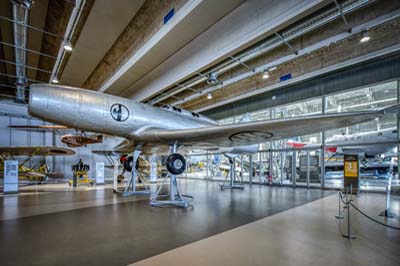 |
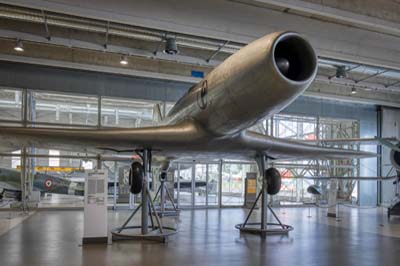 |
Caproni Campini CC.1 (MM488). Italian aircraft designers Caproni, were amongst the first to move into the age of jet propulsion. The CC.1 was one of the World's first jet aircraft, flying for the first time in August 1940. It is really a hybrid, using a traditional piston engine, combined with a compressor, combustion chambers and exhaust system, the power coming from an afterburner. Another example which was used for static testing only and is only a fuselage, can be found in the National Science and Technical Museum, in Milan.
As photographed in; 1983 and 1990. |
The Schneider Cup
The museum proudly presents aircraft resulting from Italy's participation in the Schneider Cup. A competition devised by French industrialist Jaques Schneider back in 1912. He wanted to promote seaplane production and offered a prize of £1,000 for the first team to win three of five races. The first competition held in 1913, at Monte Carlo, was won by a French pilot in a Depurdussin monoplane, at an average speed of 47.5 mph (76 Km/h) over the 31 mile (50 Km) triangular course. The Schneider Cup was then run annually, with a break for the World War One, till the final race held in 1931.
On display is the 1926 Schneider Cup winning aircraft, the Macchi M.39 (MM76 'II') in which Major Mario De Bernardi flew at an average speed of 247.5 mph (396 Km/h) over the course at Norfolk, U.S.A. This was the last race an American team took part in and was the final Italian victory.
On dispaly is also the Macchi M.67 (MM105) carrying Schneider Cup entrant number '10'. It was the third M.67 type constructed and was derived from the M.52. It participated in the now bi-annual Schneider Cup in 1929. It achieved a speed of 351 mph (561 Km/h), but was beaten by the British Supermarine S.6, at a speed of 359 mph (575 Km/h). This aircraft was returned to Vigna di Valle, in early 2004 following a five month period of restoration, its first in 80 years, by 3º RTA (10º RMV) at Lecce and the Associazione Aeronautical Restoration of Varese. This exhibit been removed by December 2010 but had returned by 2012.
Also participating in the 1929 Schneider Cup was the second prototype Fiat C.29 (MM130 '130') which flew at a maximum speed of 350 mph (560 Km/h). It also forms part of the museum collection and is the oldest Fiat in existence today. MM130 was also restored by 3º RTA (10º RMV) at Lecce.
In what turned out to be the final race in 1931, the British on the back of two previous wins entered the improved Supermarine S.6 and the S.6B which won at an average speed of 342 mph (547 km/h). Italy had entered the Savoia-Marchetti S.65 and Macchi Castoldi MC.72 but unfortunately lost two pilots, Tomaso Dal Molin and Giovanni Monti, in tragic accidents. The French who had technical problems dropped out of the increasingly dangerous event never to return. Development still continued in Italy and in 1934 Francesco Agello, in a Macchi Castoldi MC.72 (MM181) also on display achieved the world speed record for a seaplane, which still stands to this day, of 443 mph (709 Km/h). It unusually employed counter rotating propellers designed to reduce torque. |
| Macchi Castoldi MC.72 (MM181). The world’s fastest piston-powered seaplane. |
| Macchi M.67 (MM105 '10'). |
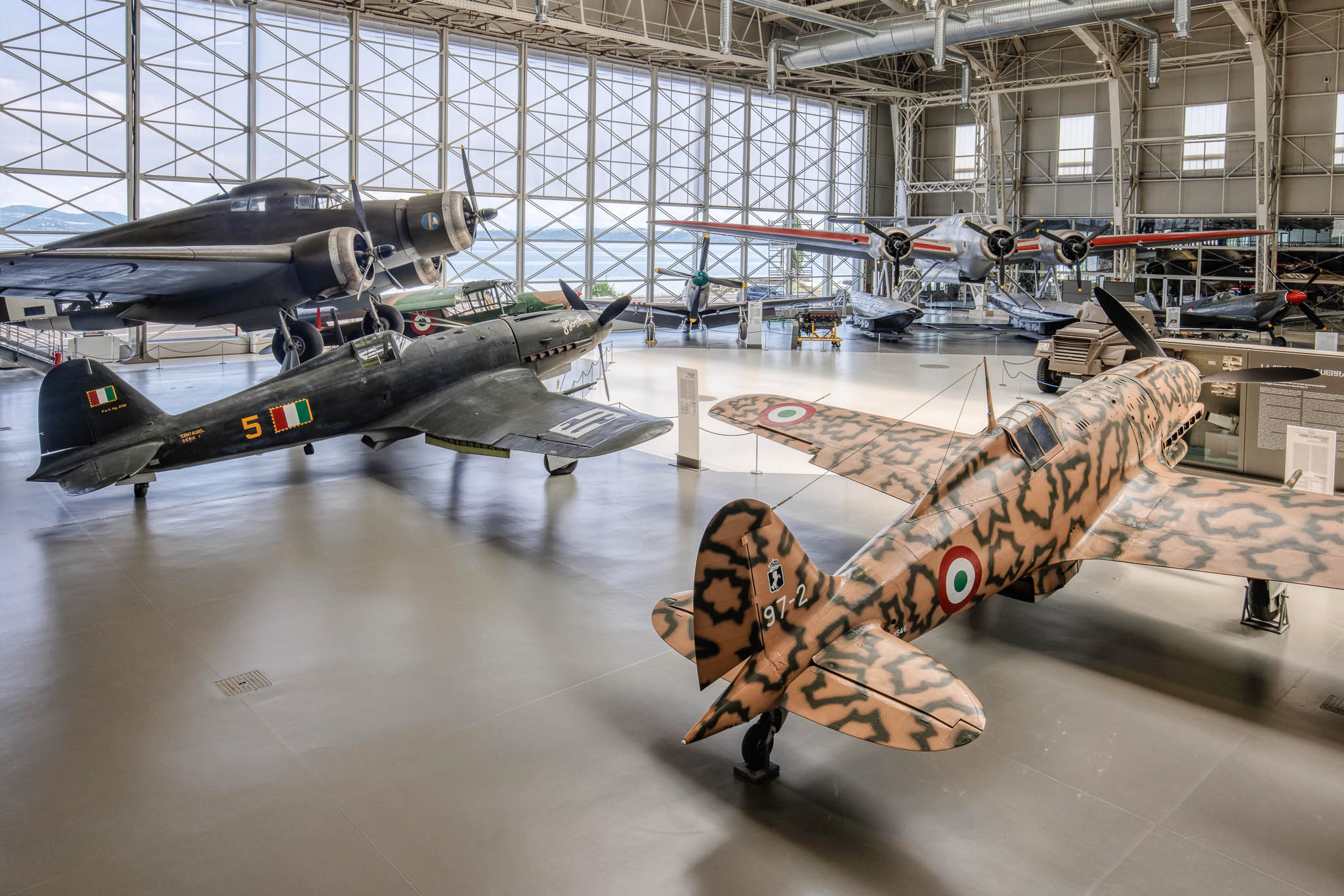 |
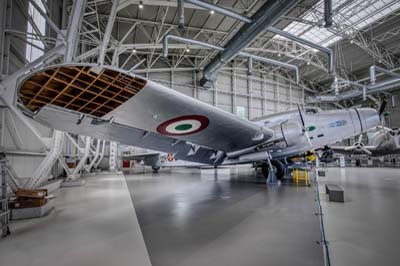 |
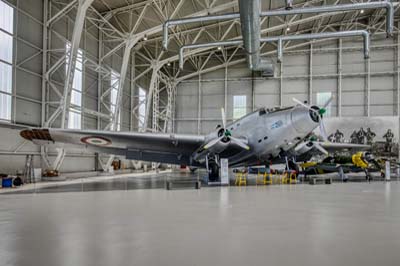 |
Savoia-Marchetti SM.82 Canguro (Kangaroo) also has three engines, it was used as a transport and bomber. Having first flown in 1939 it remained in service till 1960. It was so named as it could carry dismantled fighters in its fuselage. Based on the civil version SM.75 Marsupiale, 875 were built during the war, providing transport between Germany and East Africa. As a bomber, it carried out missions as far a field as Gibraltar and on an oil refinery in the Persian Gulf. It had a range of 1875 miles (3,000 Km). Around 250 survived to the end of the war and were used by the 36th Transport Wing based at Guidonia, till the types eventual withdrawal from service in 1960.
The example on display was painted as 'MM61850' and coded '14' (it is really MM61187) for many years and carries markings of the 'Sovereign Order of Malta' on the fuselage. These markings were applied to avoid the aircraft's destruction, as part of the armistice treaty. Some restoration work was carried out from 2004 on the wings in hall 3. By August 2006 it was painted as MM61187 and carried the code 'ZR-89' and the restoration was underway with a change of markings applied (it is now coded 'ZR-89') and by March 2008 appeared complete.
As photographed in; 1996. |
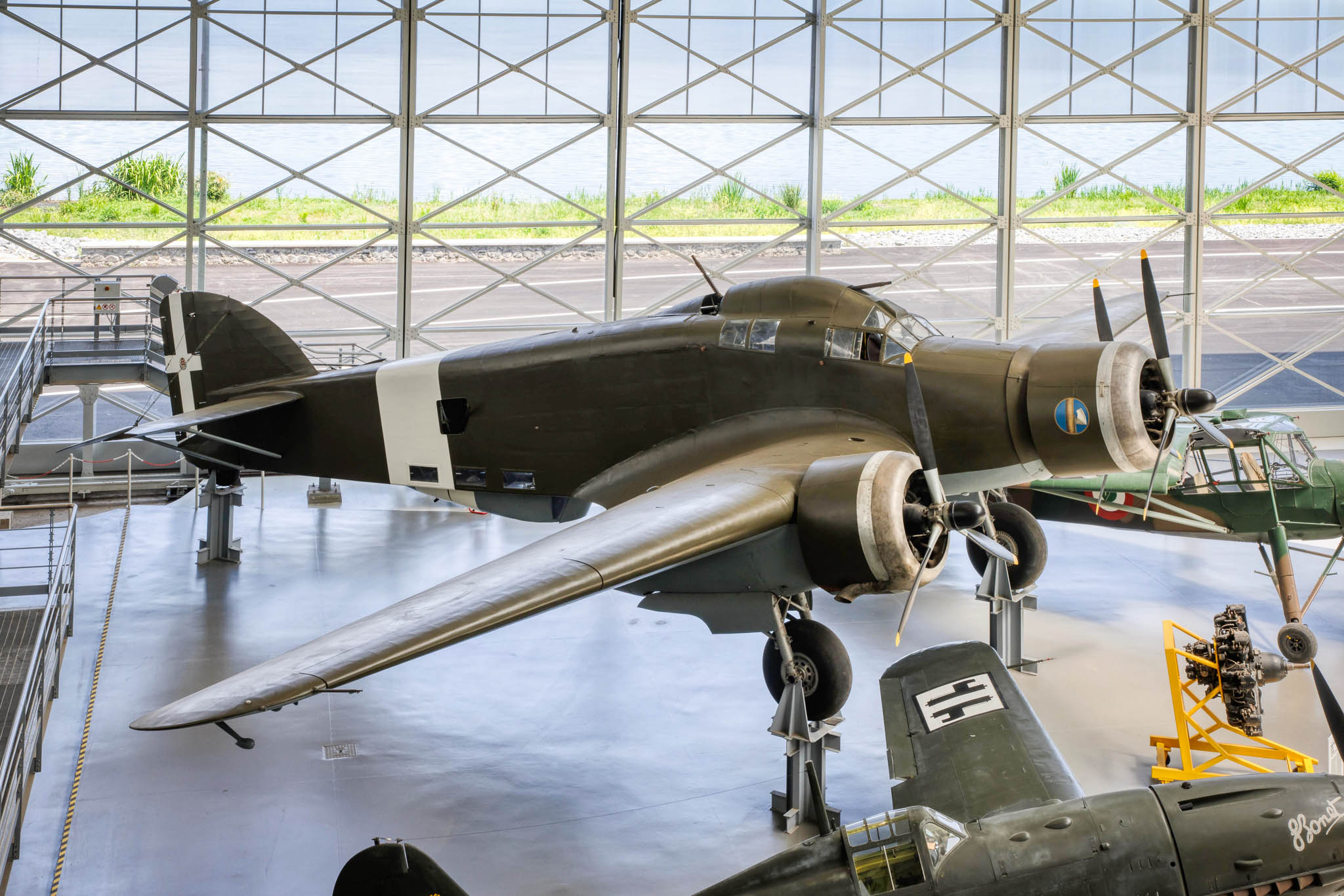 |
Savoia-Marchetti SM.79 Sparviero (Sparrow Hawk). The military version was designed to be both a conventional and a torpedo bomber, and entered service with 12° Stormo in 1936. With a crew of six and a range of 2,200 miles (3,500 Km) it flew till the early 1950s as a transport, until its retirement.
The example on display was recovered from the Lebanon, following retirement from the Lebanese Air Force, as L-112. It is restored in an Italian Air Force scheme from 1942 as 'MM24327' coded '278-2', however it is reported to be MM45508. In 2019 it was showing cracks in the fuselage skin fabric requiring attention. In May 2023 a refurbished patch-up was revealled in an all over dark green colour scheme devoid of other markings. A new fabric skin had been applied over its original skin.
As photographed in; 1990. In 2004 it was to be found in Skema hall, however in August 2006 is was dismantled again for its return to the Badoni hall by March 2008.
The only other complete SM.79 is at the Gianni Caproni Museum of Aeronautics, Trento. |
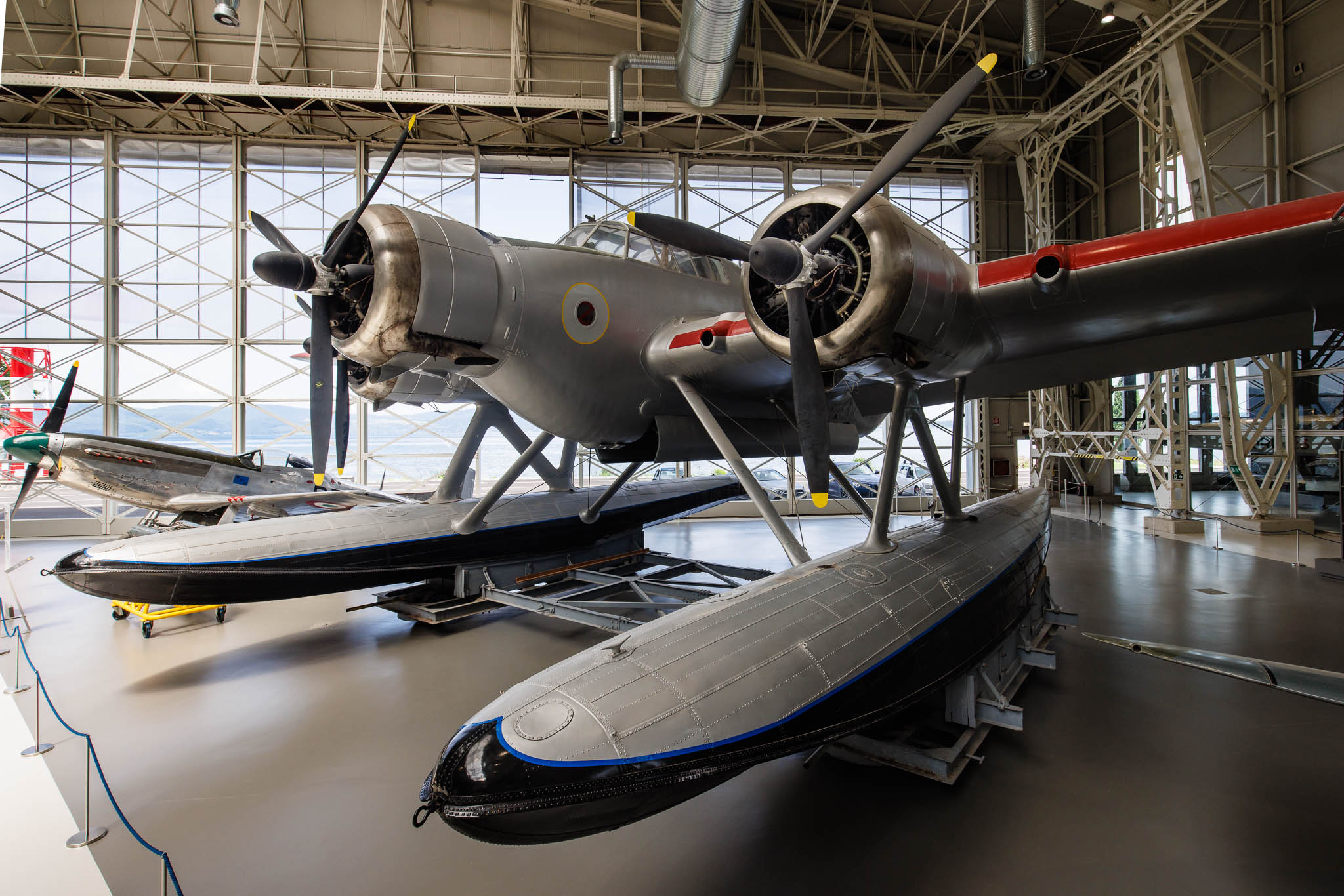 |
| The CRDA Cant Z.506S Airone (MM45425 '84-4') is one of the most impressive aircraft on display. A very large seaplane of wooden construction, it made its first flight in August 1936 and immediately gained eight World speed records and two altitude records for a seaplane. It was originally designed for commercial transport and it could carry 12 passengers. It was later developed as the faster Z.506B to drop bombs and torpedoes. It also participated in the Spanish Civil War and in World War Two. From 1937 to 1943 324 Z.506Bs were built. After the War a few Z.506Bs were converted to Z.506S standard, for its new role as a maritime search and rescue aircraft, with 84º Gruppo based at Vigna di Valle. It had a crew of five and a range of 1,690 miles (2,700 Km). The type was not withdrawn from service until 1960. As photographed in; 1983 and 2002. |
The Fiat G.212 'Flying Classroom' (MM61804 '142-5'). The Fiat G.212 'Flying Classroom' which entered service in 1948, as a cargo plane, with a range of 1,560 miles (2,500 km). It was designed in early 1940 by Gabrielli as the G.12 at the Fiat factory in Turin. The G.212 on display (MM61804 '142-5') was built in 1949 and was used to train pilots. It was equipped for photo-reconnaissance and could seat 26 to 30. It is the only Fiat produced three engine aircraft in existence.
As photographed in; 1988, 1994 and 2002. |
Left to right: Reggiane Re.2000 Falco (MM8281). It first flew in May 1939 and was transferred to the Experimental Establishment of the Regia Aeronautica at Guidonia for evaluation. The test flights were impressive attaining a speed of 322 mph (518 km/h) at an altitude of 17,224 feet (5,250 meters) performing better than other existing fighters then in production, including the MC.200 Saetta. The Directorate of Aeronautical Construction of the Air Ministry however reported flight testing unfavourably, sighting that integral fuel tanks within the wings to be highly vulnerable and prone to leaks. The project was superseded by the Reggiane Re.2002.
MM8281 had crashed off the Liguria coast during a reconnaissance training mission in 1943 when flying from Luni-Sarzana (La Spezia). Originally discovered in April 2012 in about 20 feet of water it was recovered and put through an immediate desalinization process.
The Macchi Castoldi MC.200 Saetta (MM5311 coded '369-1' is on display) employing a radial engine, was built in large numbers, but suffered from a very poor wing design, making it very difficult to fly. |
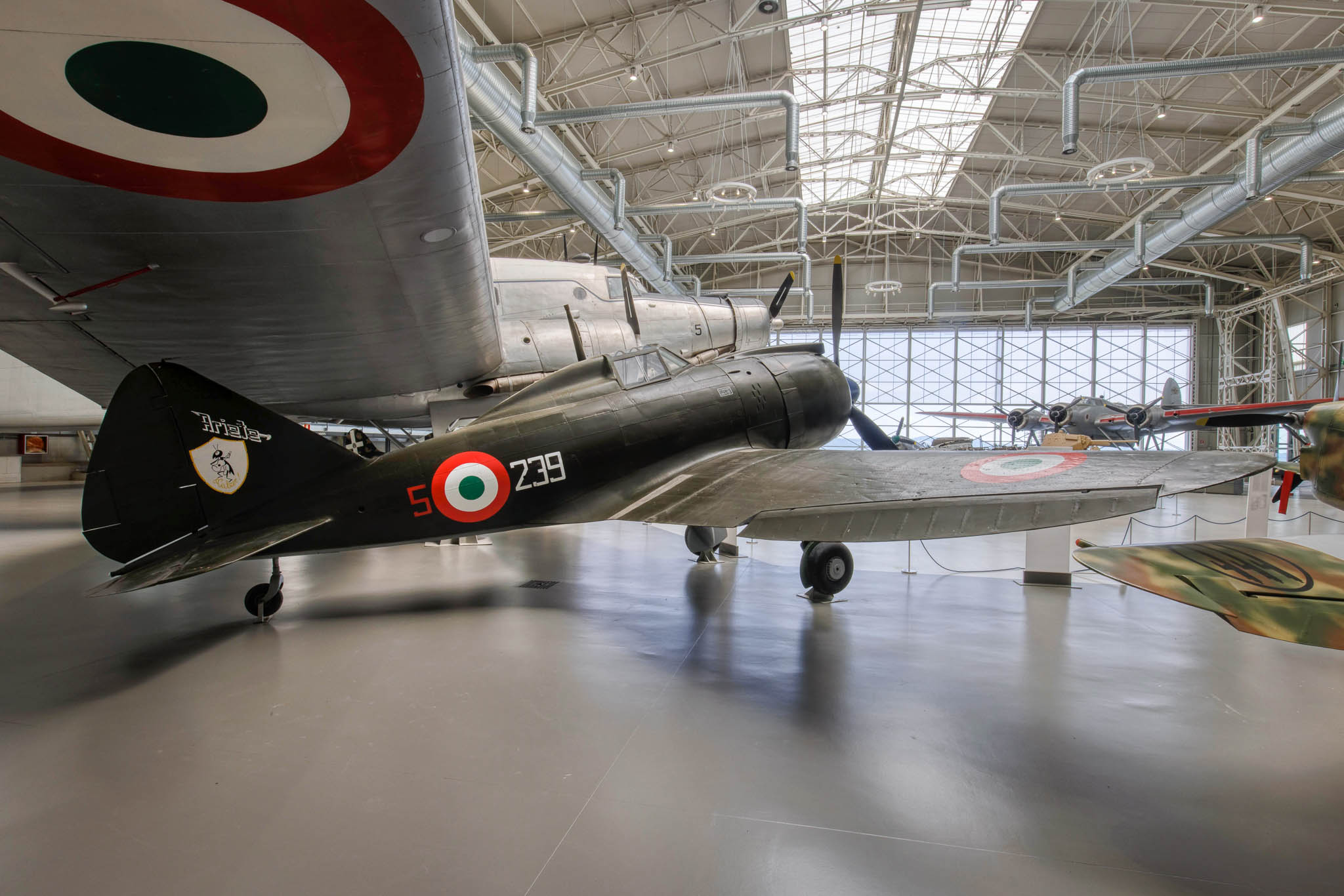 |
Reggiane Re.2002 Ariete (MM8669 '5-239') is an Italian fighter-bomber developed during World War Two. The first prototype flew in October 1940 and delivery of 100 aircraft commenced in March 1942. Total production reached 225 aircraft, with 149 for the Regia Aeronautica, the rest to the Luftwaffe. Before the Armistice September 3, 1943 Re.2002s attacked the Allied landings in Sicily suffering many losses. After the Armistice around 40 Re.2002s with the 'Cobelligerant Air Force' participated in attacks against German ships off the coast of Greece untill 1944. At the same time the Germans continued to utilise them in France.
The Re.2002 on displayis painted in the livery of an aircraft of the 239th Squadron of the 102nd Group, 5th Wing of the Italian Cobelligerant Air Force. It had been acquired by the museum in 1970 when 80% complete. Missing parts such as the engine, propeller, cowling and portions of the left wing were either sourced or built to complete the restoration. |
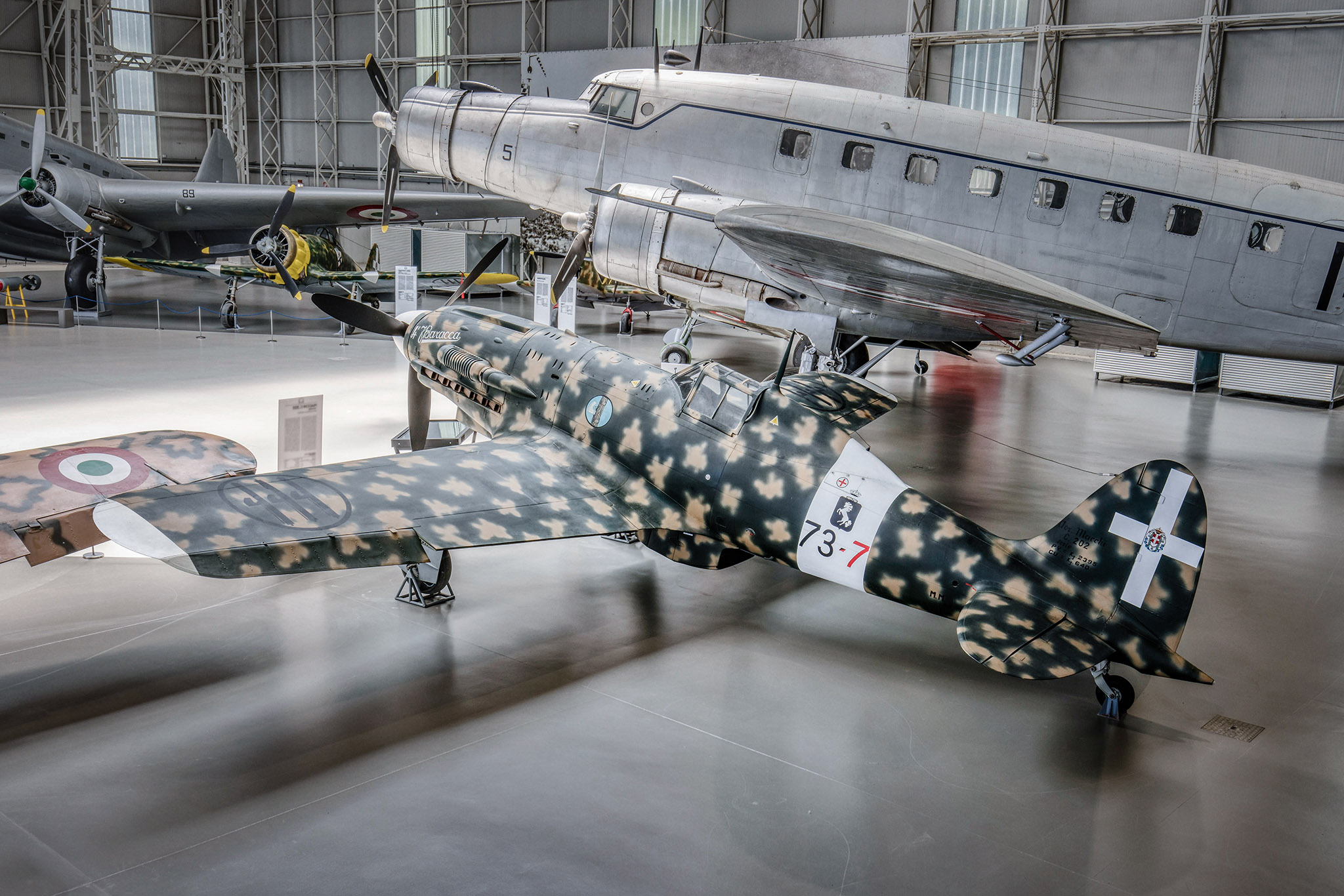 |
The Macchi Castoldi MC.202T-AS Folgore (MM9667 coded '73-7') The Macchi Castoldi MC.202 was developed from the MC.200 and was capable of 375 mph (600 Km/h). It also had two 12.7mm guns and flew in Russia and Africa.
The example exhibited, until the mid 1990s, was painted as 'MM7844' coded '91-3'. It is one of only two that remain, the other is at the National Air and Space Museum in Washington, USA.
The MC.202 Folgore and MC.205 Veltro adopted a new and improved wing design with superior Daimler-Benz engines. It was flown in support of operations on the Russian front from 1941-42 and also in Africa. It was armed with two 12.7mm guns and could carry two light bombs. After the War they were used as trainers until their withdrawal from service in 1947. |
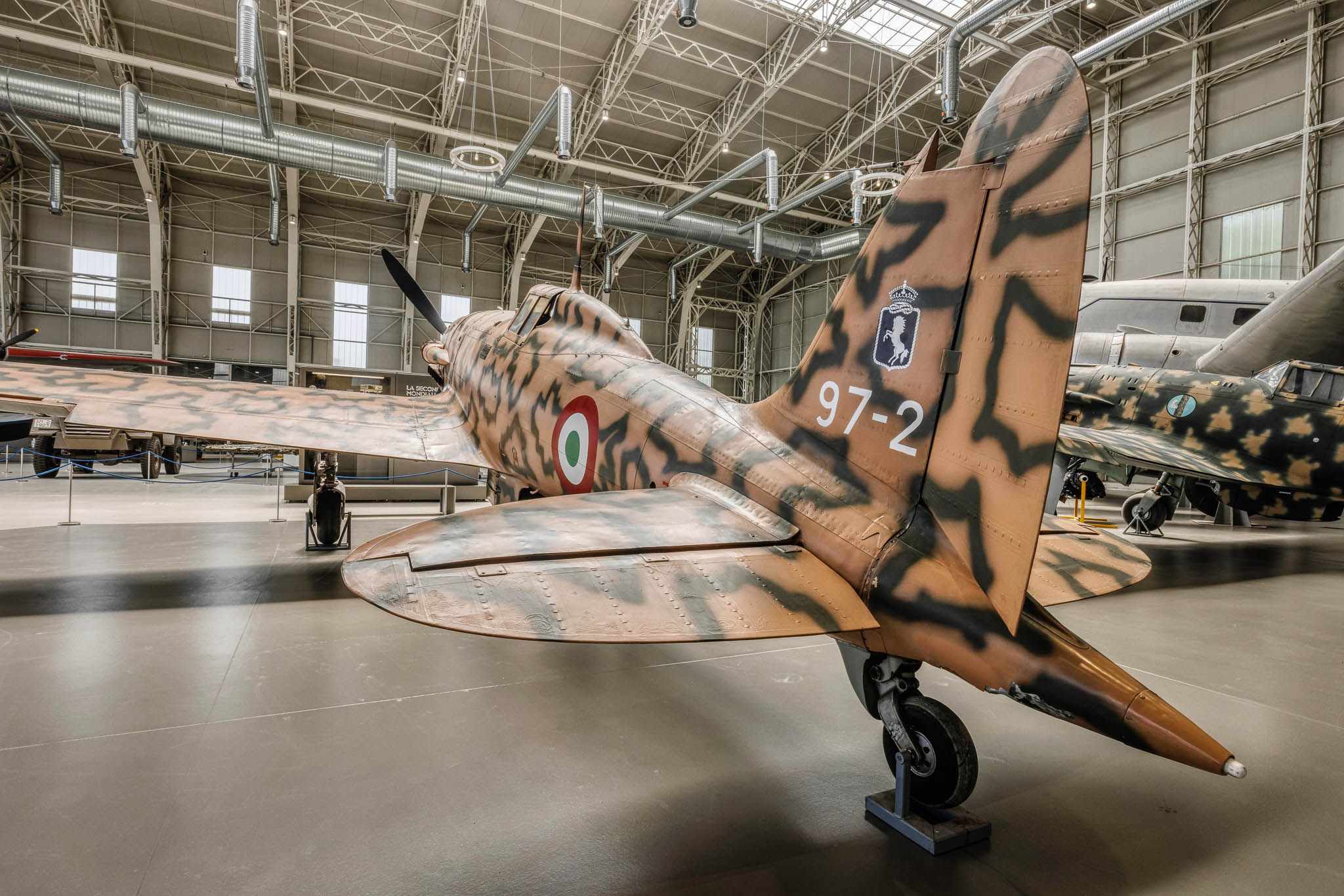 |
| Also on display is a Macchi Castoldi MC.205V Veltro (MM9546 coded '97-2' it was also painted as MM9345 '155-6' previously). The MC.205 of which 262 were built, were developed from the MC.202 first flew in 1942. The aircraft on display was converted from a MC.202 and was built at Breda in 1942. When photographed in 1996. |
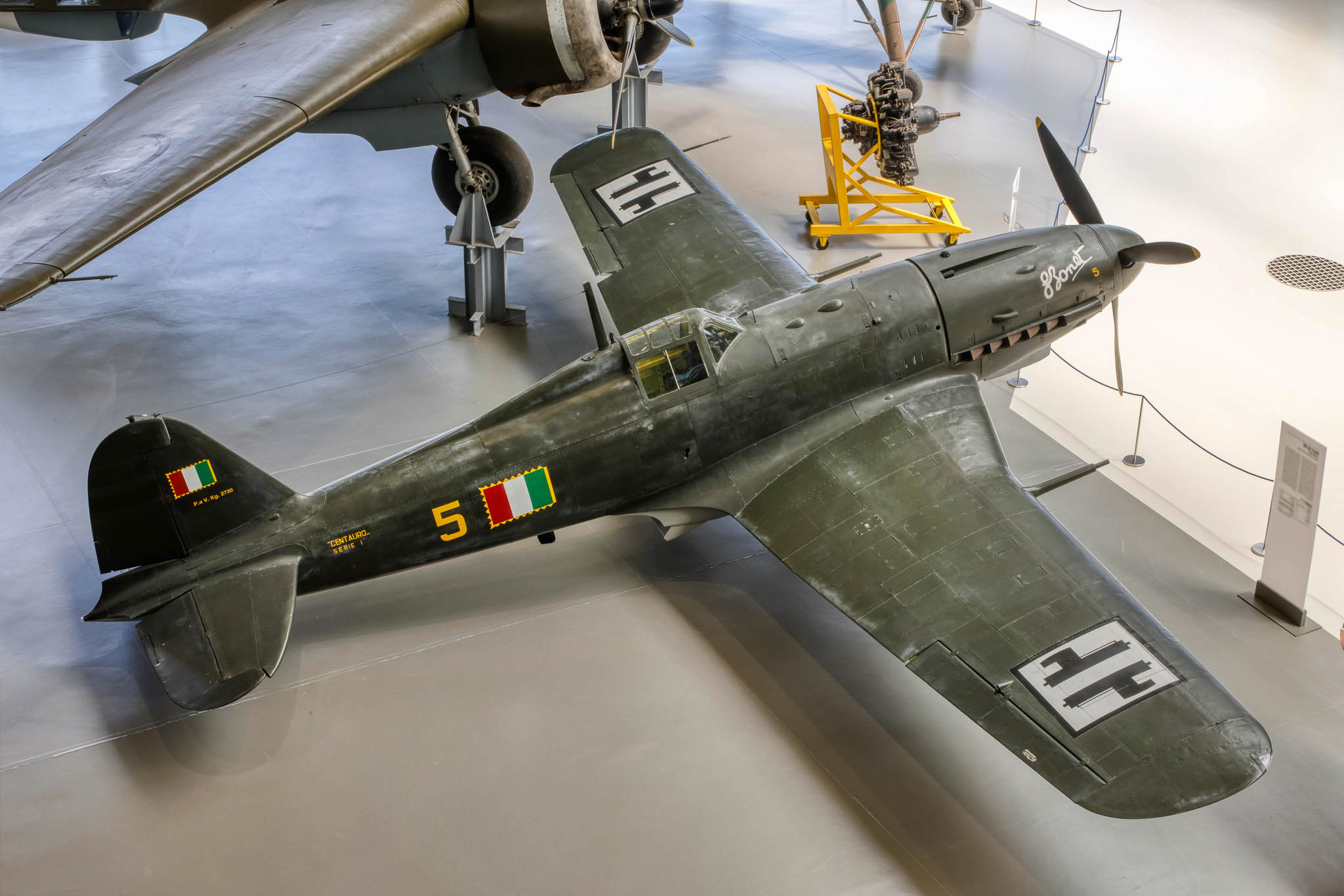 |
Fiat G.55 Centauro. It was designed by Gabrielli as a single seat fighter and produced in the Fiat factory in Turin from 1942. They were in operation by the Italian Air Force, till the armistice of September 8, 1943. After that date they were flown against the allies by the National Republic Air Force (ANR) until they were all completely destroyed.
As no G.55s survived the War, the aircraft exhibited is based on a modified Fiat G.59 (MM53265), following recovery in the 1980s from a Park of Remembrance in Novara. Restoration was started by GAVS of Turin in 1995 and was later transferred to 3º RTA (10º RMV) at Lecce. The restoration was completed in 2002. It is painted as '5' of the A.N.R of the 'Montefusco-Bonet' Squadron. |
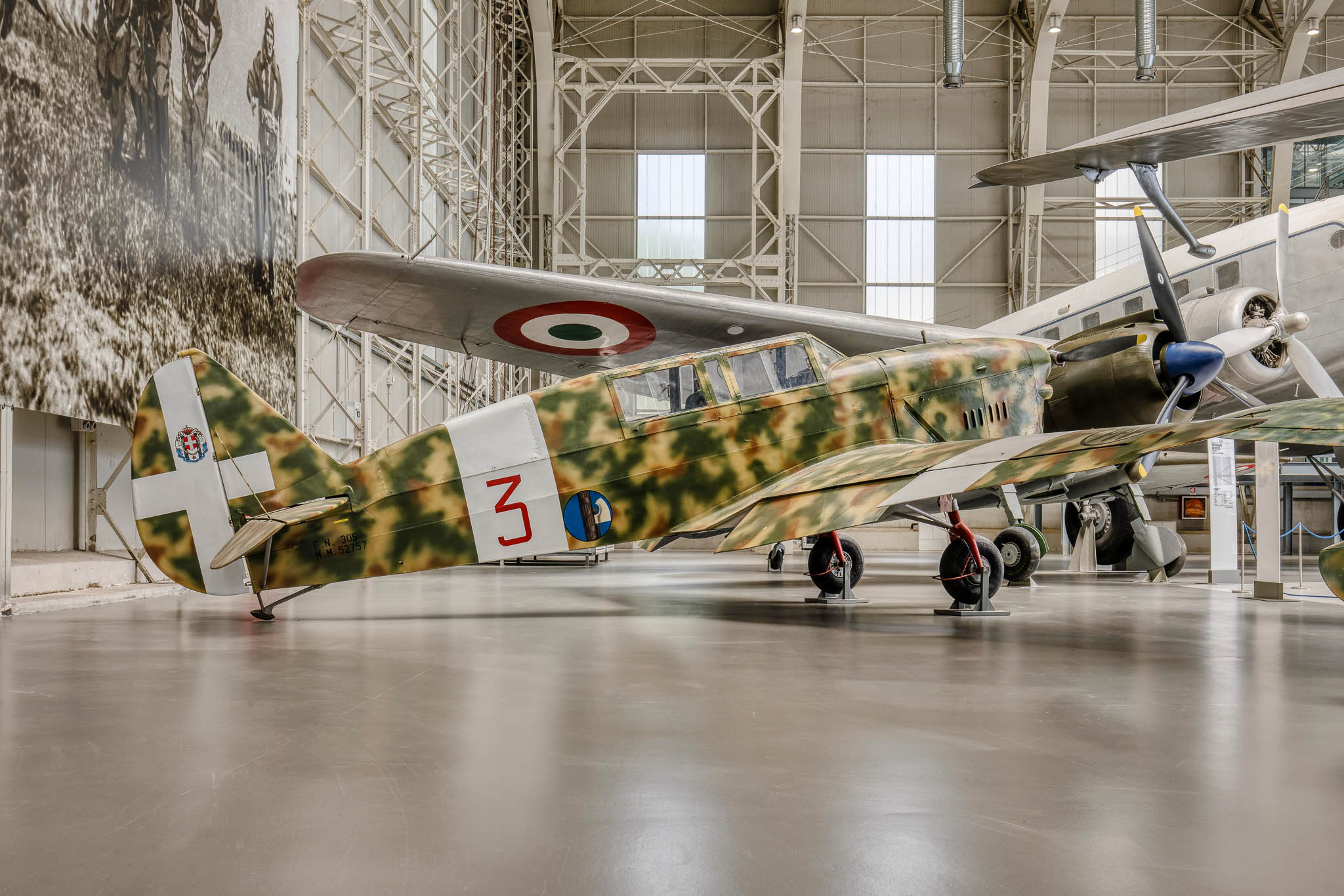 |
Nardi FN.305 (MM52757 '3' it was previously I-DASM) The Nardi FN.305 was designed by the four Nardi brothers in 1933 and made its first flight in 1935 from the Milan – Bresso airfield. Originally powered by Fiat A70 190 hp radial engines, the later Italian Air Force machines were powered by Alfa Romeo 115-1 190 hp engines and included an enclosed cockpit. They were used as advanced trainers and for liaison duties during the War. Piaggio later made these aircraft under license.
The example on display is painted in colours dating from 1940-41 when based at Perugia. It was restored by GAVS in Rome between 1994 and 2000 and is the only surviving example. As photographed in; 1990 and 1993. |
Supermarine Spitfire Mk.9 (painted as RAF MK805, it was previously MM4084). From 1944, Supermarine Spitfire Mk.5s and Mk.9s flew with the 20º Gruppo, 51º Stormo of the AMI. Later in 1946 additional Mk.9s were flown by the 5º and 51º Stormo.
The Spitfire on display was restored by GAVS in 1989. It had flown with a Polish squadron during the D-Day landings. Later handed over to the AMI it flew from Bergamo with 8º Gruppo of 5º Stormo before being withdrawn from service in 1950. |
North American P-51D Mustang (MM4323 coded 'RR-11') entered service with the AMI in 1948, it carries the personal insignia of General Ranieri Cupini who piloted it till 1953. By July 2012 it had been removed from display for restoration on-site and returned in a polished natural metal state in 2015.
Fieseler Fi-156 Storch 'Stork' (MM12822 '20' and registered G-FIST). This remarkable aircraft could take off in 50 meters and land in under 30 meters. 24 Fi-156s were operated by the AMI during World War Two. The example on display was flown by Furlo Lauro who was awarded the Gold Medal for his exploits in rescuing downed pilots and carrying personnel across the Italian front during 1944 and 1945. |
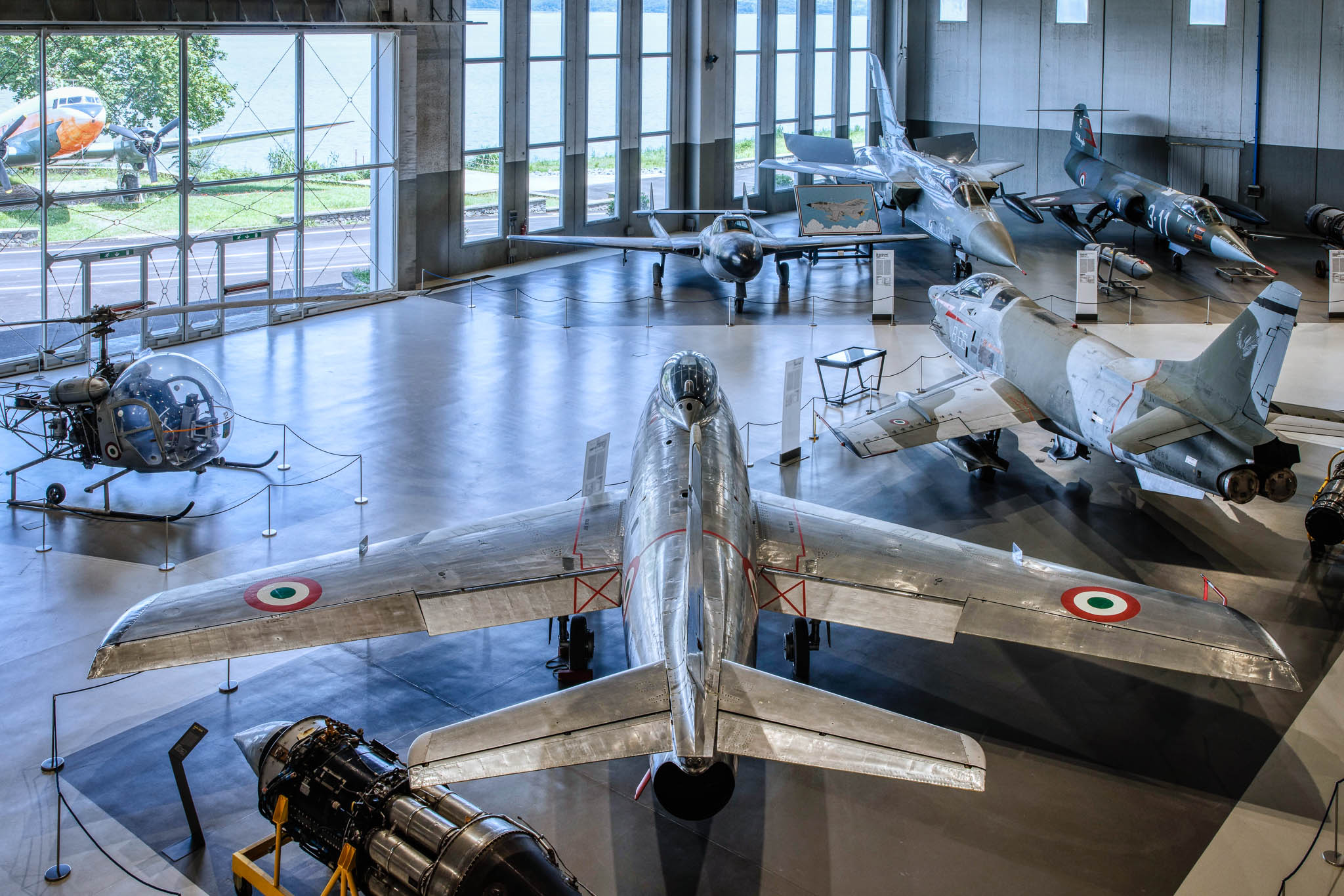 |
SAI-Ambrosini (Super) S.7 Supersette (MM558) Also built for speed and competition is the SAI-Ambrosini S.7 Supersette designed by Sergio Stefanutti. It first flew in July 1939 just in time to participate in the 'Avio Radunno del Littorio' competition against similarly fast German aircraft. Unfortunately it was not fully tested and failed to win by just a few seconds with a speed of 251 mph (402 km/h). After the War the S.7 and later the Super S.7 were developed for pilot training for the AMI. The Super S.7 on display (MM558) is the second prototype used by the Reparto Sperimentale Volo (RSV) test unit at Pratica di Mare. As photographed in; 1990 and 1996.
Fiat G-59-4B (MM53276 'SE-7'). The G.59 was developed from the G.55 and produced from 1950 onwards, it was the last piston engine fighter to be produced in the world. A single-seat and two-seat version was built, they served with the fighter school until 1965.
It arrived from the Museum of Flight in Turin in the 1970s when the museum moved south. In 2013 it was decided that this aircraft be restored in the restoration/maintenance hangar on-site. Under the paint it was discovered that it had previously been coded 'R-B+36' and later 'RM-41', however from archives an earlier code of 'SE-7' from 1957 was found for this aircraft and it was this that was applied after restoration when it was painted in a metalic sky blue scheme. It was put back on display in November 2015. As photographed in; 1983 and 1996. |
Left to right: Fiat G.46-4A (MM53286 'Z-17' ex I-AELM c/n 192) The G.46 is of aluminum construction was designed by Giuseppe Gabrielli as a two seat trainer, sitting in tandem. There was also a single seat version. The G.46 first flew in 1948, before going into production in the following year. The Italian Air Force received 141 aircraft. 70 of these aircraft were passed on to Italian Flying Clubs by the end of the 1950s and remained in use till the 1970s. Today only five G.46s remain airworthy, apart from two in Italy (MM53491 registered I-AEKT and MM53304 registered I-AEKA at Montegaldella November 2004), there is G-BBII (ex MM52801 registered I-AEHU) from the Aircraft Restoration Co, Duxford (since 1992), US based N46FM (MM53091 registered I-AEHX) and OO-VOR (ex MM53293 registered I-AEKI) of the Vormezeele Collection in Belgium. Fiat G.46-4A (MM53283) was here in 1983.
This exhibit was first observed in 1980 and was on display until noted in 1996 after which it went to Pratica di Mare where it performed taxi runs at air shows. It returned after restoration at Lecce/Galatina in October 2011.
Aermacchi MB.308 Macchino (MM53058 'SG-8' it was previously registered I-GORI in 1950) it had been operated by Ministero della Difesa - Aeronautica. A side-by-side basic trainer of wooden construction with a tricycle landing gear, it first flew from Venegono in 1947. The AMI ordered 80 MB.308s and operated them until the 1950, when 40 aircraft were transferred to civilian flying clubs from whom they served well until the late 1960s.
Stinson L-5 Sentinel (MM52848 'S-1 2' it was previously I-AEEU registered in 1954) previously operated by Ministero della Difesa - Aeronautica it was recovered from the Aero Club at Turin and restored. Around 100 of these aircraft were used by the AMI for basic training from 1946. As photographed as I-AEEU in 1990. |
| Macchi M.416 (MM53762 'AA-48' it was previously I-AELY when registered in 1962) and was supplied as a basic trainer for the Italian Air Force from 1951. Originally designed by Fokker as the S.11 'Instructor', as a side-by-side light trainer, it made its first flight in 1947. 178 M.416s were license built by Macchi, subsequently, following development of better performance aircraft, the AMI passed them on to aeroclubs throughout Italy. As photographed in 1996. |
Left to right: North American T-6G Texan (MM54097 'RR-67'). The AMI took delivery of the T-6 under the MDAP agreement to enable their pilot training to meet the new NATO standards. Deliveries ran from 1949 to 1958 (T-6C, AT-6D, T-6G and T-6H) and totalled over 200, most training units operated the aircraft. The T-6Cs and T-6Ds were eventually converted to T-6G standard and they remained in service until the end 1970s. The example on display was transferred to the museum in 1974 following its retirement as a liaison aircraft with the 2º Reparto Volo Regionale at nearby Guidonia and in whose colours it is displayed. It was restored by GAVS Vicenza from 2001 to 2002. As photographed in; 1983 and 1996.
SIAI-Marchetti (Aermacchi) SF.260AM (MM54436 '70-36'). This military variant of pilot training aircraft was designed by Stelio Frati in the 1960s, it is fully aerobatic. In 1976 the AMI bought 45 examples for basic flying training duties. The final flight was made on September 19, 2009 by 70° Stormo at Latina the 'AM' version having logged 235,500 flight hours was superseded by the SF.260EA. The example on display was one of the last four to fly and arrived at the museum in Decmber 2011. |
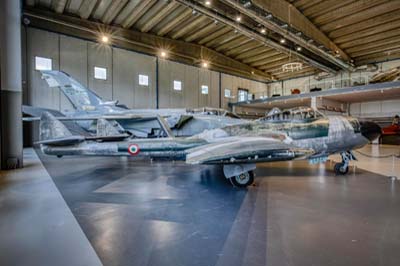 |
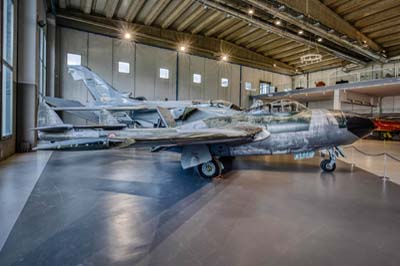 |
| de Havilland DH.113 Vampire NF.54 (MM6152). From 1950 the AMI took delivery of a number of Vampires, prior to a producing their own (150 in total) by Fiat and Macchi. |
Left to right: Ambrosini Aerfer Sagittario II 'Ram' (MM561). The first of two prototypes it first flew in May 1956 and became the first Italian aircraft to break the sound barrier, with a speed of Mach 1.1 on controlled dive. Ultimately, it was an unsuccessful protoype fighter. It returned to the museum after some years away (last seen April 2002) by August 2009. As photographed in 1988.
Ambrosini Aerfer Ariete (MM569) another prototype fighter, which was based on the Aerfer Sagittario II 'Ram'. Built in 1958 it first flew in March of that year. With less than expected results the project was cancelled and no further examples were built. |
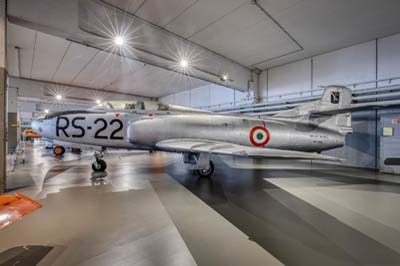 |
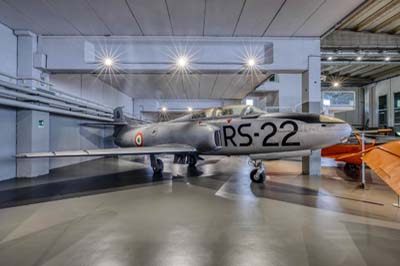 |
Fiat G-80 (MM53882 'RS-22'). Fiat built, the G-80 which was designed by Gabrielli as an advanced two seat jet trainer. The first flight of one of the two initial prototypes, took place in December 1951. Later in May 1953 one of the two prototype G-82s, made its first flight. Another four G-82s were built and were transferred to the jet training school at Amendola. They eventually went on to the 'Reparto Sperimentale di Volo' (RSV) in 1957. The AMI were not too impressed by the performance of the G-80 and G-82 consequently and losing out to the MB-326 no further orders were forthcoming.
The Fiat G-80 on display is one of three pre-production aircraft that were built and tested by the R.S.V. at Pratica di Mare, in who's markings it still carries. MM53882 'RS-22' was on display outside here for many years, but following the opening of Skema hall it was restored and moved inside. Two of the G-82s (MM53886 'RS-19' and MM53888 'RS-21') were also stored outside the museum from it's earliest days until the mid 1990s when they returned to Pratica di Mare where they are now held in open store. |
| Republic RF-84F Thunderflash (MM27458 '3-05') on display for a number of years but had gone by March 2008 for restoration by 156º Gruppo, 36º Stormo at Gioia del Colle and returned by July 2014. |
Republic F-84F Thunderstreak (MM53-6892 '36-38') on display for a number of years but had gone by November 2005 and returned in March 2009, following restoration by 936º GEA in the authentic colours of 156º Gruppo, 36º Stormo from Gioia del Colle. The 'Diavoli Rossi' (Red Devils) became an official aerobatic team in 1958 and consisted of seven Republic F-84F Thunderstreak aircraft.
This aircraft was on display for a number of years but had gone by November 2005 and returned by August 2009. |
Left to right: Canadair CL.13 Mk.4 (F-86E) Sabre (MM19792 '13-1') The North American F-86 first flew in 1947. Over 1,800 were built by Canadair under licence as the CL.13. 179 surplus RCAF CL.13s were transferred to the AMI in 1955. The example at the museum was transferred to Vicenza in October 2004 for restoration and returned by August 2009.
North American F-86K Sabre (MM55-4868 '51-62'). Derived from the F-86E the F-86K was built under licence by Fiat in Turin and first flew in May 1955. Eventually 221 were built in Italy. The F-86K on display was one of a batch received from France in 1962 to supplement the Italian built aircraft. It served with the 23º Gruppo, 51º Stormo at Istrana-Treviso before it passed to the museum in 1971. It was on display for a number of years but had gone by November 2005 and returned by August 2009. |
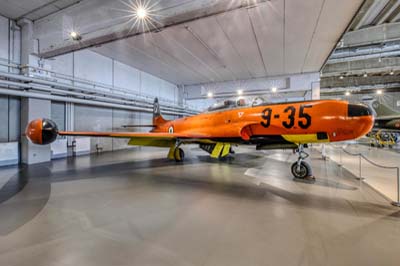 |
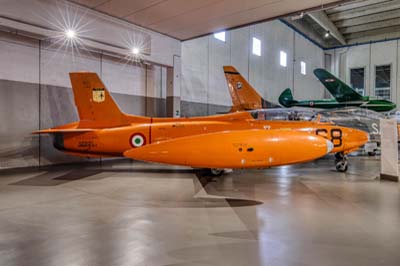 |
Left to right: Lockheed RT-33A Shooting Star (MM53-5594 '9-35'). The T-33A was based on the single seat P-80, first flying in 1948. The AMI received 60 T-33As from 1952 and 14 single-seat RT-33As. The aircraft on display is a RT-33A and is painted in a high visibility scheme dating back to its days with 9º Stormo (9 Wing), 609º Gruppo (609 Squadron) when employed on target towing duties. As photographed in 1990.
Aermacchi MB-326E (MM54389 '68') Designed by Bazzocchi at Macchi, the first of two prototype (MM571 and MM572) MB-326s first flew on December 10, 1957. It eventually won the competition with the Fiat G.80 to be accepted by the AMI. An initial order of 15 pre-production aircraft was followed by an order for 100 more in 1960. It entered service on January 15, 1962, replacing T-6 Texan, for primary jet training with 214º Gruppo flying school at Lecce-Galatina which was renamed as "Scuola Volo Basico Iniziale Aviogetti" (see badge on tail) at the same time. It was powered by a Rolls-Royce Viper engine. An additional twelve MB-326Es were ordered later, which included the aircraft on display. In 1982, after 20 years and more than 400.000 flying hours with the MB-326 was replaced by the MB339A. |
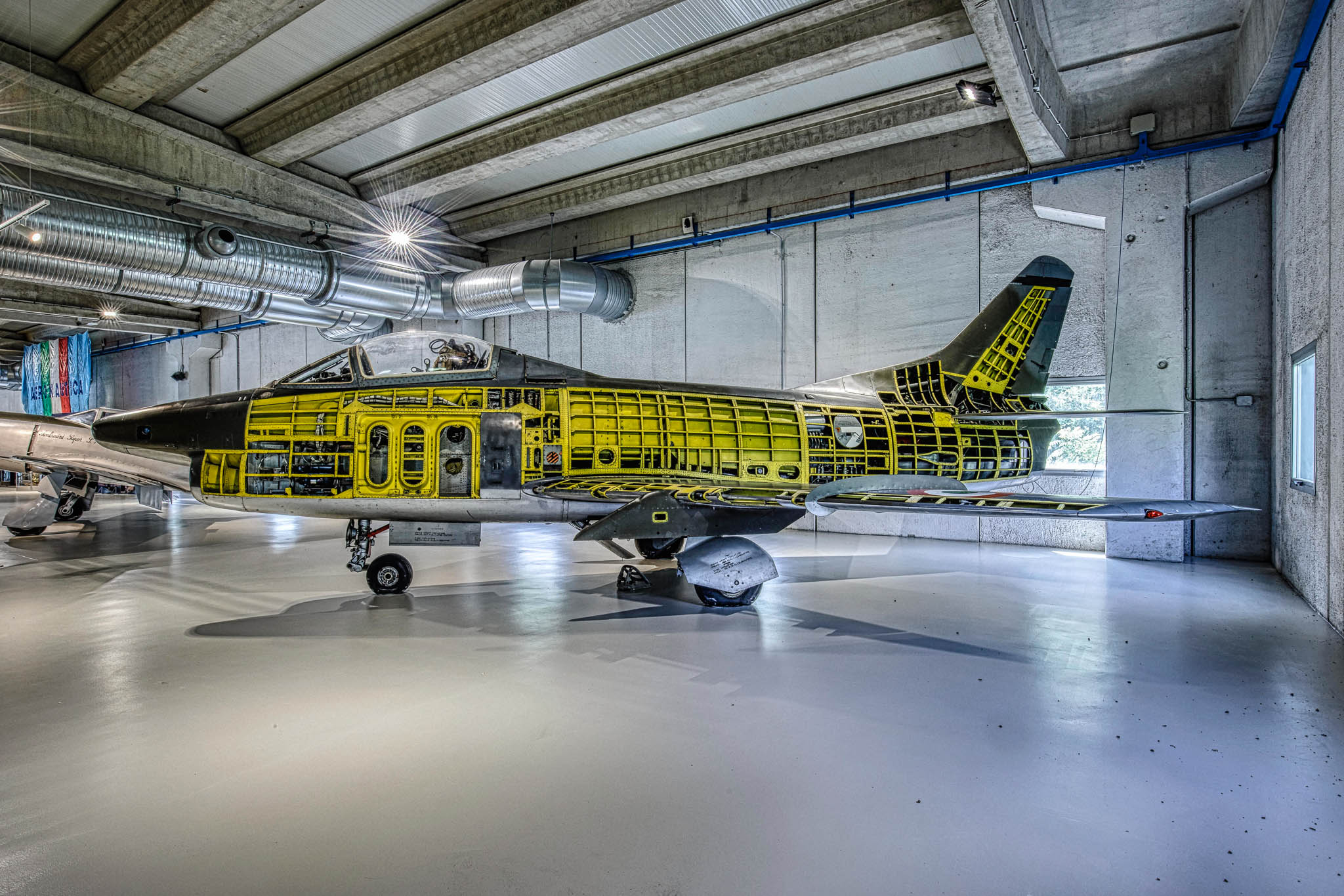 |
Fiat Aviazione (later Aeritalia) G-91R (MM6280 '2-33') which has the panels cut away on the port side only.
Other G-91s have passed through the museum (including MM6405 '2-05' first seen August 1996 but had gone by March 2008) over the years.
Two-seat Fiat Aviazione (later Aeritalia) G-91T (MM6344 'SA-47' previously exhibited as '32-44'). |
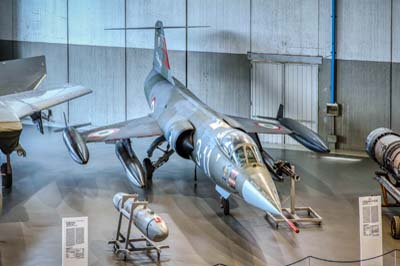 |
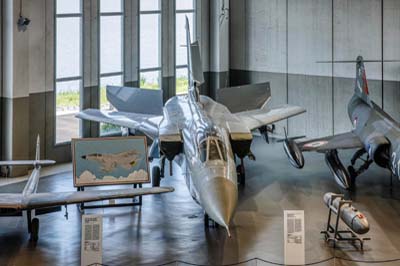 |
Left to right: Lockheed F-104G Starfighter (MM6501 '3-11') The first F-104A Starfighter flew in 1954. Production of the multi-role, all-weather strike fighter was started in many of the countries which adopted this unique aircraft, apart from Fiat/Aeritalia, including Fokker in Holland, Messerschmitt in Germany and SABCA in Belgium. As photographed in 1994.
The initial batch of 12 two-seat TF-104G Starfighter's were manufactured by Lockheed and assembled by FIAT from 1965. The F-104G had a maximum speed of 1,328 m.p.h. at 35,000 feet and could climb to 90,000 feet. The first F/RF/TF-104G Starfighters entered service with the AMI in 1963 to replace the F-86 and F-84s. FIAT eventually manufactured 164 F-104G, 119 RF-104G and 245 F-104S 40 of which were exported to Turkey. The S for 'Sparrow' variant was an improved F-104G capable of fulfilling the air-to-ground attacking role utilising the R21G/H ground mapping contour following radar and deliveries were completed in 1979. Some aircraft were later upgraded to F-104S ASA standard to carry the Apside and AIM-9L air to air missile from 1988. The F-104Gs remained in service until 1983 and the last AMI Starfighter was not withdrawn until 2004.
The Panavia Tornado F.3 ADV (MM7210 '36-12', formally with the Royal Air Force as ZE836) which replaced another Tornado (MM7001 'RS-01') which had been here for well over ten years when last noted in November 2005. |
Left to right: Agusta Bell AB-47G (MM80113 '12') The first Agusta Bell AB-47G flew on May 22, 1954 and were employed in the training role initially with the Centro Elicotteri and later the Scuola Volo Elicotteri (SVE). The later J models remained in service until the 1970s.
Agusta Bell AB-47J (MM80187 'SE-38') which was operated by the Scuola Volo Ellcotteri.
Agusta Bell AB-204B (MM80357 'RM-112') Based on the Bell UH-1, it is a utility helicopter including Search and Rescue (SAR) and first appeared here in 2009. |
Left to right: Agusta-Bell HH-212 (MM81161? '9-61').
Sikorsky HH-3F Pelican (MM80986 '15-15').
Agusta-Sikorsky SH-3D/TS (MM80973) It has been especially equipped for VIP transport with the 31° Stormo and was better known as 'the Pope's Helicopter' as it was in service as such for 35 years up to it's retirement following it's final flight from Ciampino to Vigna di Valle on October 17, 2012. |
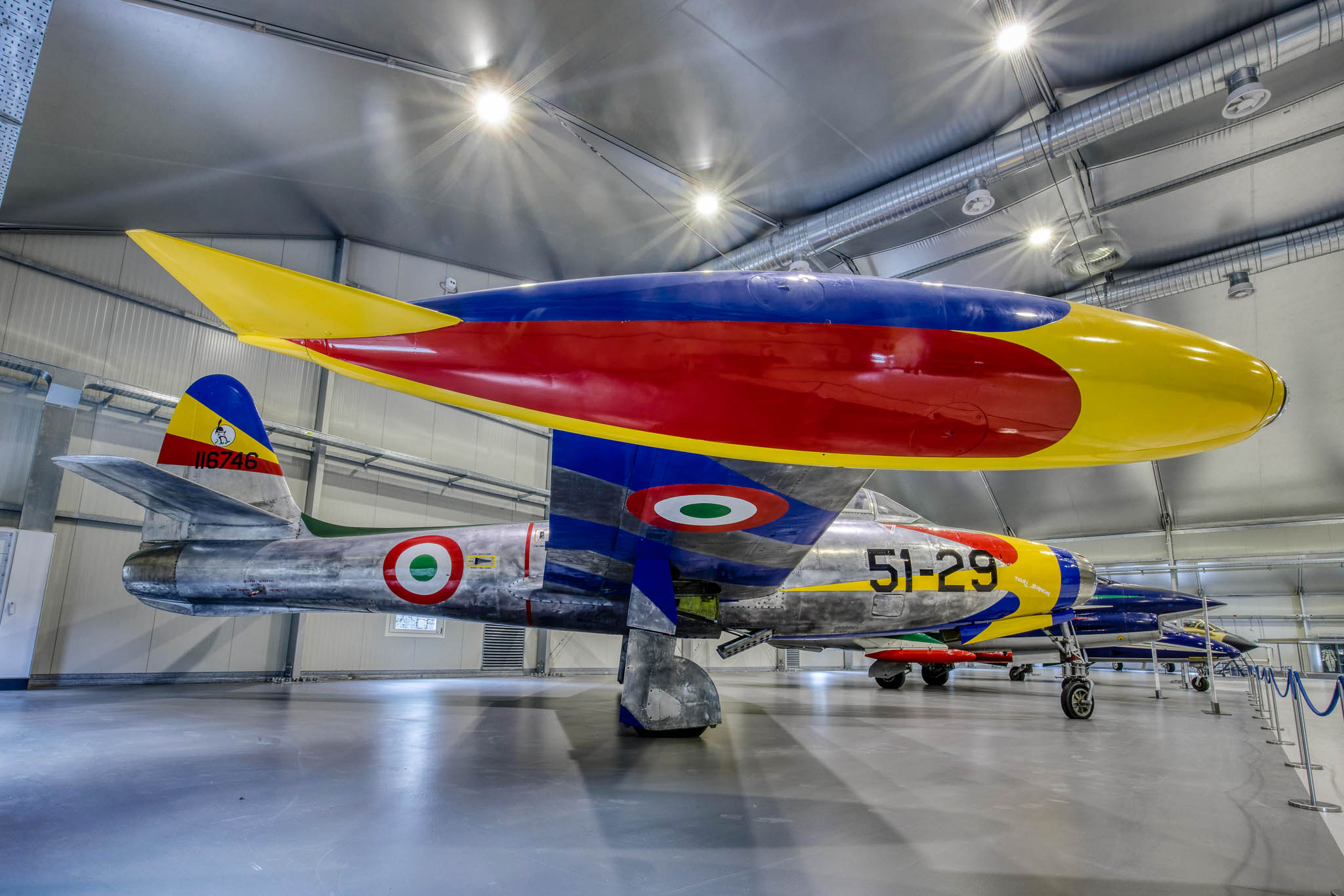 |
Republic F-84G Thunderjet (MM111049 '51-18' now painted as MM116746 '51-29'). The F-84G first flew in 1946 and eventually 4,400 were built and used throughout NATO. From May 1952 the AMI took delivery of 254 F-84Gs, assigning them to 5º, 6º and 51º Stormo. They were very popular aircraft, due to their impressive performance and handling. Two display teams, the 'Getti Tonanti' in 1953 with 5º Stormo at Villafrance air base and the 'Tigre Bianche' from 1953 to 1956 with 51º Stormo, both flew the F-84G. The AMI F-84Gs were replaced by the 'F' and 'RF' versions from 1956. The F-84F Thunderstreak was an F-84G, but with a swept wing, over 2,700 were built, supplied mostly to NATO countries.
The aircraft on display was originally stored at Capodichino airport, Naples for many years following a crash, before being restored by 51º Stormo. It was painted in the special colours applied for the 1956 Fiumicino Air Show and was on display as such till February 2008 before returning from restoration by 51º Stormo at Istrana in February 2009 in a different special scheme and inscribed on the nose 'Tigri Bianche' (White Tiger). |
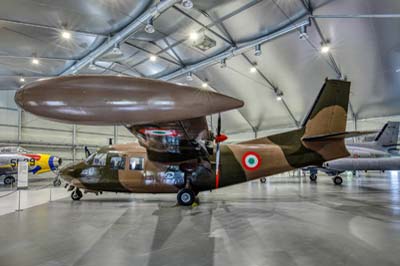 |
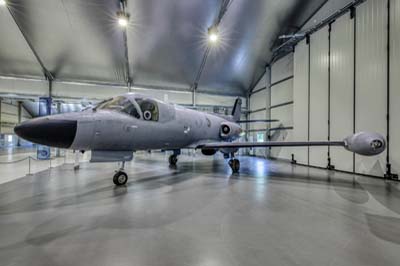 |
Left to right: Piaggio P.166ML1 (MM61933 '53-34'). The P.166s design followed on from the P.136 amphibian of which several were to be seen at the museum until the mid 1990s when they were put into store at Guidonia. The first prototype P.166 took to the air in 1957. The P.166 was used for multi-engine aircraft pilot training at Latina with Scuola Volo Basico Avanzato Elica (SVBAE) and also for transport, liaison and Search and Rescue (SAR). 303º Gruppo at Guidonia utilised the P.166M/APH for aerial surveys until its retirement in 1997. Piaggio P.166ML-1s MM61874 and MM61890 were here in 1986 but had gone by 1993.
Piaggio Douglas PD-808GE (MM61961) The PD-808 first flew in August 1964 and only 27 were built. The example on display last flew on May 17, 2003, when with 71º Gruppo at Pratica di Mare and employed in the ECM role.
It was first seen in August 2004 in Badoni hall, by August 2006 it had placed outside the hangar and by March 2008 it had been moved towards the car park to make room to the extension to Skema hall. |
Left to right: Aermacchi MB-339A/PAN (MM54485 '0') painted as display team Frecce Tricolori '0', it arrived at the Museum on December 4, 2012. Deliveries of the MB-339A began in 1979.
Fiat Aviazione (later Aeritalia) G-91PAN (MM6250 '9') painted as display team Frecce Tricolori '9'. |
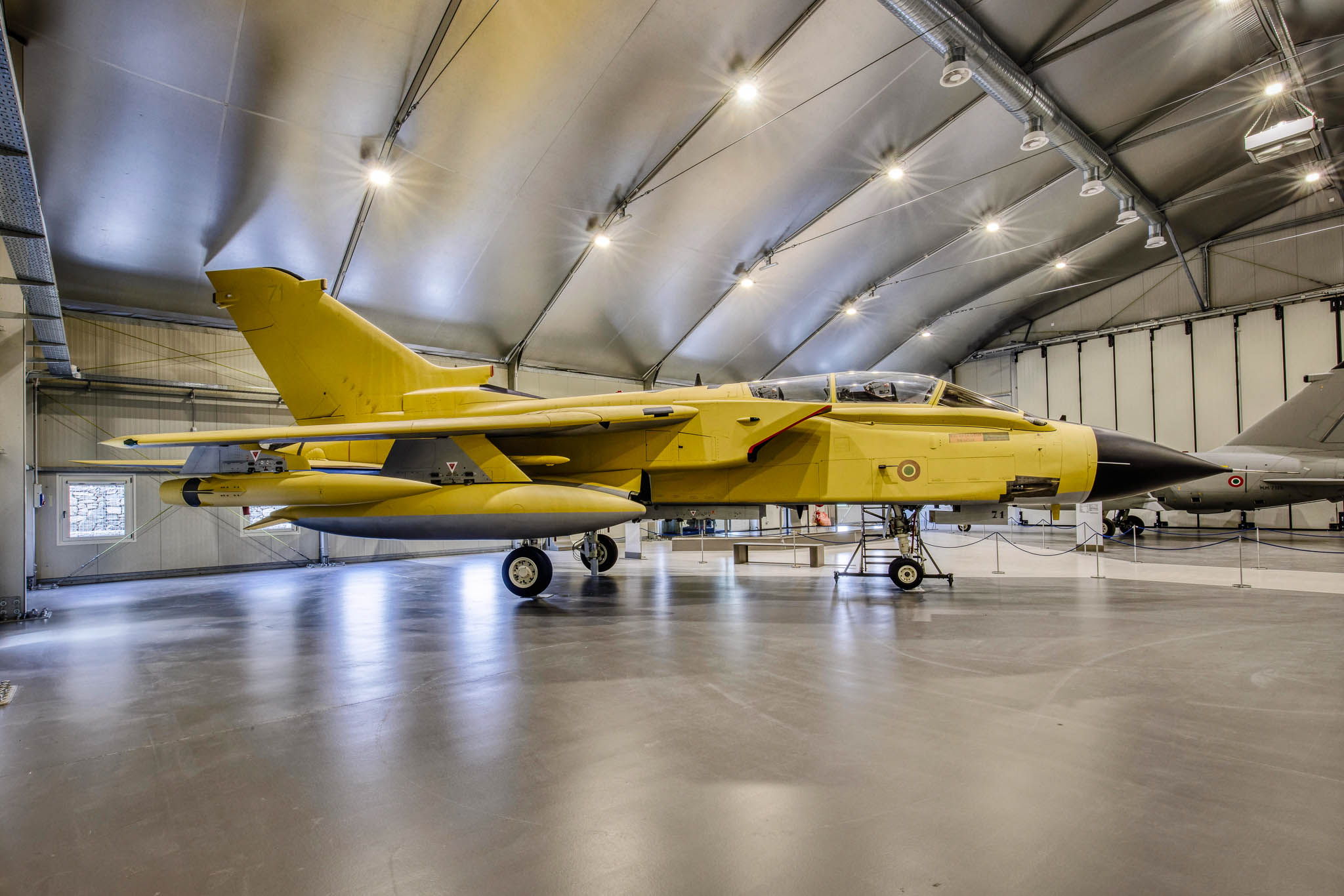 |
Left to right: Panavia Tornado IDS MLU (MM7071 '71'). Painted in a 1991 Gulf War desert yellow ‘Canarino’ scheme, as applied for Operazione Locusta when part of Operation Desert Storm.
Alenia/Aermacchi/Embraer AMX (MM7125 'RS-11') An Italian-Brazilian joint venture the AMX was designed for the; ground-attack, close air support and the reconnaissance role. In Italy the AMX was introduced to replace the G-91. The 1981 agreement between the Italian and Brazilian Governments was for 187 and 100 aircraft respectively, all components were built either in Italy or Brazil. The prototype first flew in May 1984 and in 1988 the first production aircraft flew by 1989 51° Stormo, 103° Gruppo started receiving its first AMX. The two-seat AMX-T was developed from 1986 and it first flew in 1990. |
| General Dynamics F-16A Fighting Falcon (MM7251 '37'). |
| Grumman HU-16A Albatross (MM50-179 coded '15-5'). They were used for Search and Rescue (SAR) operations by the Italian Air Force (Aeronautica Militare Italiana or AMI) from 1958. The aircraft on display operated with 85º Gruppo of 15º Stormo based at Rome Ciampino. It's last flight was in 1978 to the Museum when it landed on Lake Bracciano. By 2006 following years out in the open its paint had deteriorated, in March 2008 it had been repainted. As photographed in; 1980 and 1993. |
Douglas C-47A (MM61776 '14-45'). On display at the museum by 2004 the C-47 was formally with 14º Stormo and subsequently been in open store at Guidonia for decades, along with some other less fortunate examples before it was rescued, repainted and put on display.
40 DC-3/C-47s were supplied to the Italian Air Force from the 1950. They were used for multi-engine training, VIP transports and numerous other duties. |
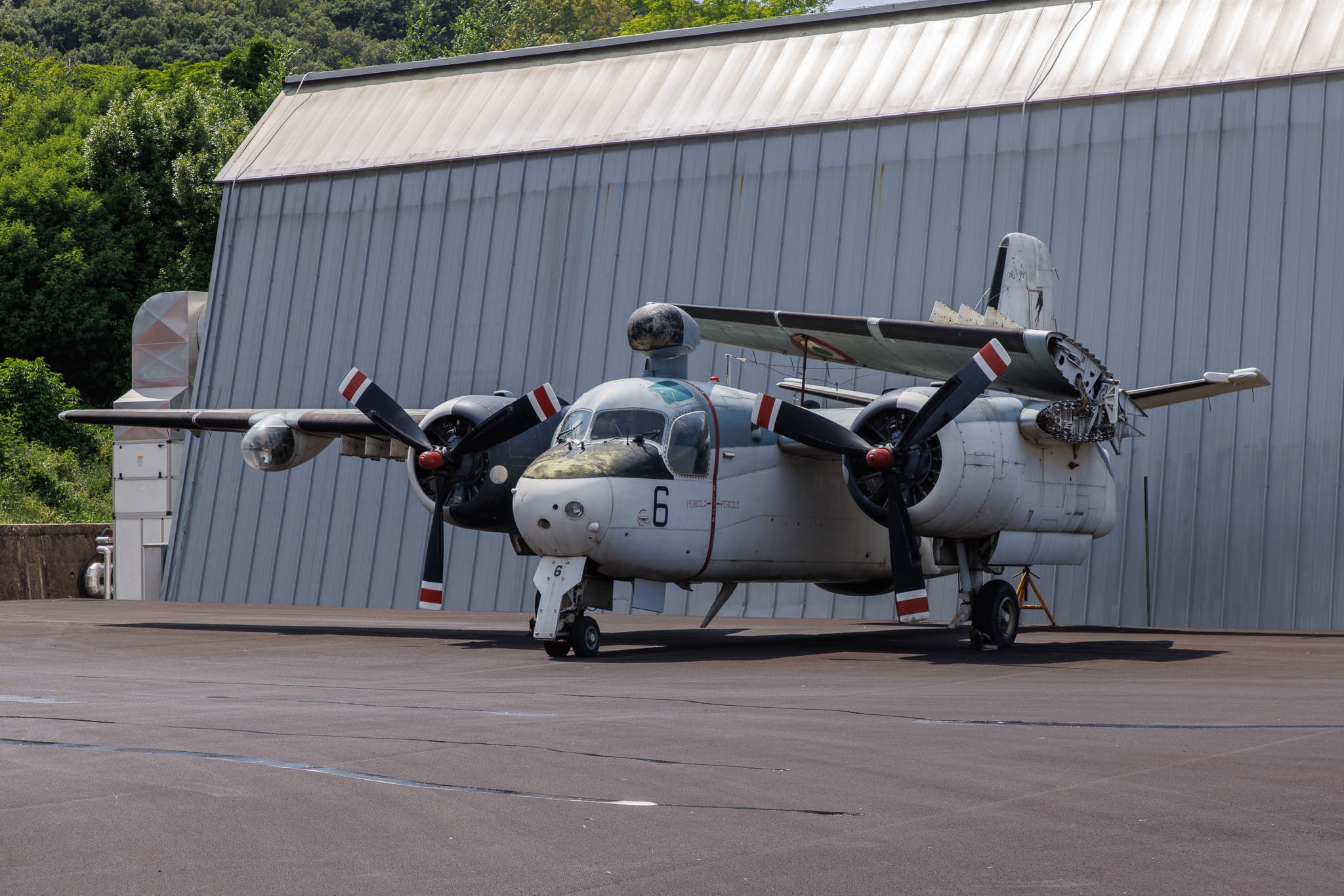 |
Grumman S-2F Tracker (MM136556 '41-6'). The prototype Tracker (XS-2F-1) first flew in 1952 and entered service two years later. The aircraft was employed in Anti-Submarine Warfare (ASW) duties by a number of countries. Deliveries of the S-2F began in 1957 to the AMI under the United States Military Defense Aid Program (MDAP). The S-2F-1 was later designated the S-2A, although the AMI continued to use the original designation. The first six were delivered to Capodichino in 1957, followed by another 14 in 1959 and a further 10 in 1961 all to Brindisi. A final delivery of 15 aircraft followed in 1964. The aircraft were later operated by two squadrons (30º and 41º Stormo) based at Sigonella in Sicily remained in service until its gradual withdrawal in the 1970s when replaced by the Bréguet Atlantic. The last AMI Tracker flew on August 31, 1978.
The Museo Storico also has on display the nose of another Tracker (MM148295 '41-35') which was part of a batch that did not have the wing-folding mechanism. It was first seen here in 2004 more than 20 years after the complete example was put on display, which was the first aircraft delivered to the AMI. As photographed in 1996. |
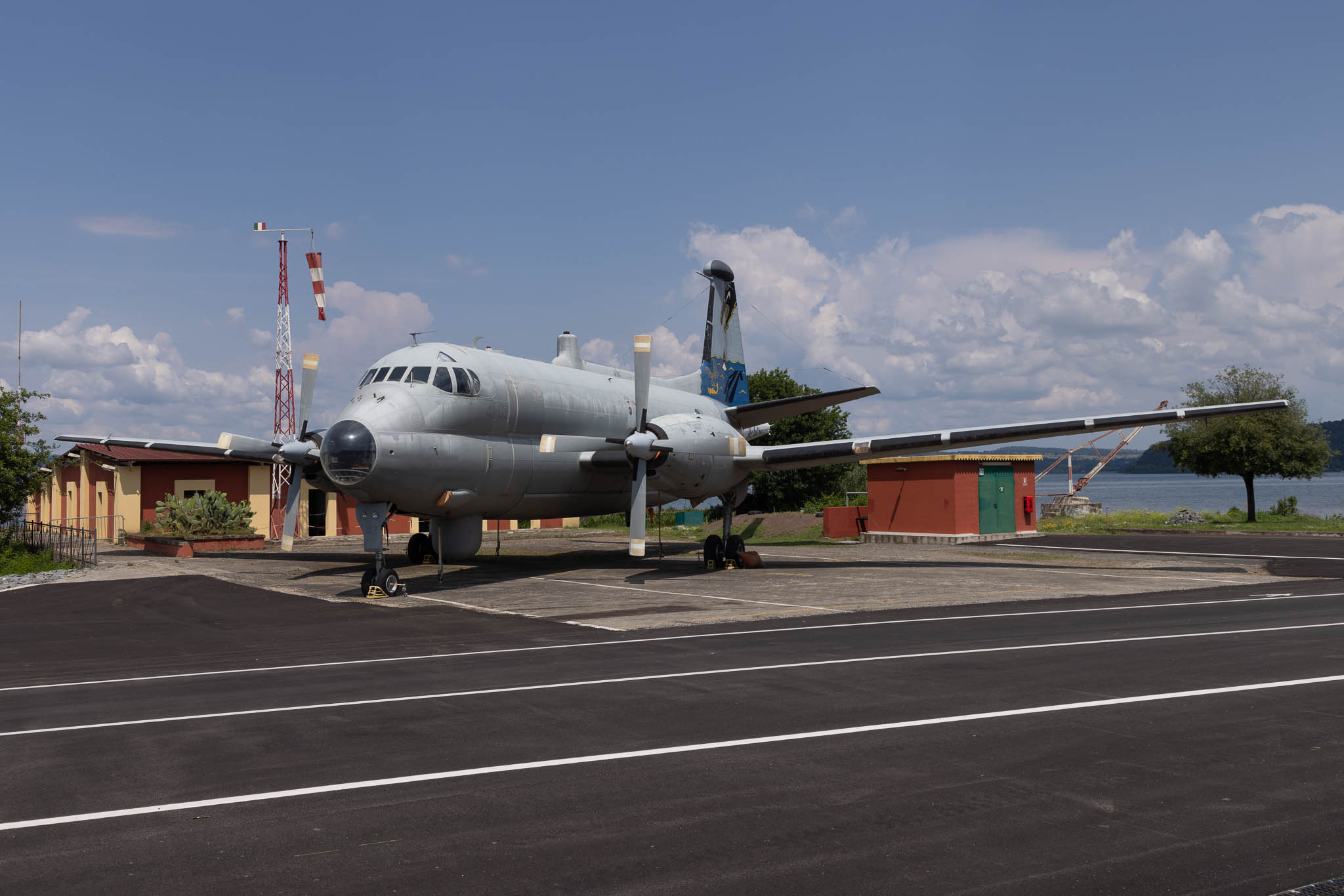 |
| Bréguet 1150 Atlantic (MM40118 '41-03') was retired on November 22, 2017 after its final flight from Sigonella, home of the 41° Stormo the final AMI unit to operate the Atlantic. It arrived on October 18, 2018, airlifted in sections by a S-64 Skycrane. |
| Piaggio P.136 or P.166? For years I have been chasing the stored P.136s without success, they were here in the 1980s and were at 6 Deposito Centrale AM Barracks and/or Torricola but now possibly moved to Piacenza air base in 2022/23. Some reports have suggested that at least one of them is missing its wings. So is this on base winged monument utilsing wings from one of those P.136s or a P.166? They are silver but look a little more like P.166 wings. |


